Abstract
The Ossa-Morena Zone (SW Iberian Massif) hosts the largest set of Cambro–Ordovician alkaline magmatic plutons related to the Palaeozoic rifting of the northern Gondwana margin so far described. An organized framework for their classification at different scales is proposed through data-driven ranks based on their distinctive petrological features relative to other rift-related magmatic rocks found throughout western Europe. The classification method aims to enhance geological mapping at different scales, regional- and continental-scale correlations, and, as such, facilitate the petrogenetic interpretation of this magmatism. The hierarchical scheme, from highest to lowest rank, is as follows: rank-1 (supersuite) assembles rocks that have distinctive characteristics from other magmatic units emplaced in the same magmatic event; rank-2 (suite) categorizes the units based on their major textural features, indicating if the body is plutonic, sub-volcanic, or a strongly deformed magmatic-derived unit; rank-3 (subsuite) clusters according to their spatial arrangement (magmatic centres) or association to larger structures (e.g., shear zones or alignments); rank-4, the fundamental mapping unit, characterizes the lithotype (alkaline granite, alkaline gabbro, syenite, albitite, etc.) by considering higher ranks (alkalinity and textural aspects); rank-5 characterizes the geometry of individual plutons (with several intrusions) or swarms; rank-6 (smallest mappable unit) corresponds to each intrusion or individual body from a swarm. Although this classification scheme is currently presented solely for the Ossa-Morena Zone, the scheme can be easily extended to incorporate other co-magmatic alkaline bodies, such as those in the NW Iberian allochthonous units or other peri-Gondwanan zones or massifs, in order to facilitate regional correlations of the rift-related magmatism.
1. Introduction
The systematic hierarchization of lithodemic units is a key aspect of the geological mapping of intrusive, deformed, and metamorphosed rocks. The effective classification of such units facilitates the consistent and accurate interpretation of regional geological processes, providing a standardized framework for better comparisons and correlations of geological units at a global scale. In highly deformed terranes, establishing the nomenclature and relationships between intrusions of similar nature and related magmatic-derived tectono-metamorphic units contributes to the deepening of knowledge regarding tectonic events, magmatic processes, and regional metamorphism [1,2,3,4]. The implications of a well-defined hierarchized nomenclature in igneous provinces or belts go beyond the possibility of large-scale interpretations, as locally, it can contribute to delineating the spatial relationships between igneous bodies (centres, clusters, swarms, or alignments), as well as emphasizing the individual massifs and their internal architecture [2]. The thorough ranked classification enhances the knowledge of complex magmatic systems and, when significant, their tectono-metamorphic evolution from local-scale to province/terrane-scale, and therefore, it is useful for a range of applications, like paleogeographic reconstruction or mapping and the management of natural resources. Several broad classification methods have been proposed, ranked, compared, and reformulated to systematize the nature of the magmatic rocks associated with specific events, and they have been employed for different purposes [1,2,4,5,6,7,8,9]. These range from geological mapping and determining large-scale tectono-thermal events to regional assemblages of rocks with similar compositional features and economic significance.
In this work we present a hierarchical classification of the Cambro–Ordovician rift-related alkaline magmatic rocks of the Ossa-Morena Zone (OMZ, Figure 1; SW Iberia) using a ‘6-ranks’ method, partially following recommendations from the revised North American Stratigraphic Code (NASC), the British Geological Survey Rock Unit Classification System (BRUCS), and the Cooperative Lithodemic and Stratigraphic System (CLASS) [2,3,4,10]. The systematic grouping of such rocks provides, beyond the criteria for applications in geological mapping at different scales, the framework for further studies of alkaline magmatic systems, as it outlines the extent of relatable bodies and assists with correlations across analogous magmatic segments throughout the peri-Gondwanan terranes. We avoid inferences on the regional delineation of large igneous provinces and their volume or timespan, as well as metallogenic provinces. Our interpretation assumes that the alkaline rocks represent pulses from a larger tectono-magmatic event (the Palaeozoic rift of the Gondwana northern realm) and therefore are part of a large rift-related igneous province that includes other magmatic-derived units. The necessity of a complete classification of the OMZ alkaline bodies independent from the other OMZ rift-related magmatic rocks (e.g., tholeiitic mafic rocks or peraluminous granitoids [11,12,13,14,15,16,17,18,19,20]) is derived from the mappable lithological variations with implications in the petrogenesis and the potential ore-forming systems known to develop in such alkaline magmatic environments [6,21].

Figure 1.
(a) Location of the Ossa-Morena Zone (OMZ) within the tectono-stratigraphic zonation of the Iberian Massif (adapted from [22,23]). (b) Major structural domains of the OMZ, adapted from [24,25], separated by the major shear zones from [24,26,27]. The grey area corresponds to the sinistral Tomar–Badajoz–Córdoba Shear Zone [28].
2. Geological Setting
The Iberian Massif comprises the geological units related to the final stages of the Cadomian Orogeny (late Ediacaran) and the subsequent Variscan Cycle, i.e., the Palaeozoic opening and closure of the Rheic oceanic basins, which culminates with the Laurussia–Gondwana continental collision that formed Pangea [29,30,31,32,33,34]. The Palaeozoic evolution of the Iberian Massif is characterized by the Cambro–Ordovician rifting [15,17,35], followed by the Ordovician–Lower Devonian passive margin [25,36], and finally the mid-Devonian–Carboniferous subduction and continental collision [29,32,37]. The processes related to the Variscan cycle imposed a tectono-stratigraphic zonation throughout the Iberian Massif [23], with different tectono-magmatic and metamorphic characteristics depending on the distance from the Rheic suture zone [38,39,40,41,42,43,44,45,46,47,48,49]. The OMZ corresponds to the outer zone of the Iberian segment of the Gondwana margin and is therefore characterized by distinctive sedimentation and magmatic patterns. This zone can be further compartmentalized by structural or tectono-stratigraphic domains [24,25,27] (Figure 1b), majorly composed of variably metamorphosed and deformed successions (e.g., [17,25,50,51,52,53,54,55]), as well as synorogenic sequences [56,57], thermal domes [47,58,59], and collision-related plutonism that persisted mainly during Carboniferous times [11,46,48,60,61,62,63,64].
All segments of the OMZ comprise key elements for understanding the influence of the Cadomian Orogeny and the subsequent rifting of northern Gondwana, which culminated with the opening of Rheic and related oceans [34]. Evidence for the reconstruction of the Cadomian orogen is well preserved in the Zafra–Alanís and Obejo–Valsequillo domains and to a lesser extent, in the Abrantes–Sardoal domain and in the Central Unit, the Tomar–Badajoz–Córdoba Shear Zone (TBCSZ) [28], as well as in the Olivenza–Monesterio Anticline. In these domains, remnants from oceanic-affinity units (developed in fore-arc and back-arc environments) [65,66,67,68,69] and from the major arc-building and arc-related volcanism [70,71,72,73,74,75,76,77,78,79,80] have been found.
The oldest sedimentary units are the Ediacaran Série Negra Group, deposited in the arc basins during the ca. 600–545 Ma interval [51,81]. The arc system ceased at ca. 541–534 Ma [70,82]. The regional rift-related lithostratigraphic Cambrian succession discordantly overlays the Série Negra Group and includes (from the bottom to the top): Lower Detrital (LD), Detrital Carbonate (DC), Upper Detrital (UD), and Main Rift (MR) sequences (e.g., [15,17,27,83]).
The coeval magmatic activity is widespread in the OMZ and is characterized by an early event of subalkaline felsic magmatism progressively followed by a subalkaline to mildly alkaline bimodal main rift event from ca. 539 to 500 Ma [11,13,14,15,16,17,18,20,58,59,84,85] and the later persisting subalkaline [54,86,87,88,89,90] and mildly alkaline to peralkaline bimodal magmatism from ca. 500 to 470 Ma [12,19,91,92,93,94]. Most of the rift-related magmatism in the Galicia-Trás-os-Montes and Central Iberian zones (GTMZ and CIZ) consists of subalkaline rocks, i.e., peraluminous granitoids and tholeiitic mafic rocks, emplaced during the late rift event (e.g., [83,87,95,96,97]). However, in specific segments of the GTMZ (in the lower allochthonous), the magmatism achieved alkaline and peralkaline composition and is also represented by alkaline granitoid orthogneisses [98,99,100] and alkaline metavolcanic rocks (e.g., [101,102,103,104]), which are prone to be correlated with the alkaline magmatism of the OMZ. In regions where these rocks are described, alkaline magmatism generally postdates subalkaline magmatism [91,98,99]; in contrast, in areas lacking evidence of alkaline rocks, the peraluminous character persists into later stages [95,96,105]. While the subalkaline magmatism is pervasive in the OMZ, sections with documented alkaline magmatic bodies emplaced during the later rift magmatic events are restricted to the central-north domains. This includes the Alter do Chão-Elvas domain (in Portugal), with a lithostratigraphic sequence that ramifies into the Elvas–Cumbres Mayores and the Zafra–Alanís branches, as well as the Olivenza–Monesterio Anticline (in Spain) and the Central Unit (Figure 2 and Figure 3). In this work, thorough geological mapping was conducted to access the geometry, textures, and main mineralogical features of the alkaline magmatic rocks in Portugal and confronted with information from published works. Alkaline massifs from the Spanish side are well characterized in published maps and the literature, on which we based our ranked classification.
Besides Iberia, the Cambro–Ordovician rift-related magmatism is also found in other segments of the rifted margin of northern Gondwana, namely in the Armorican, Central, and Bohemian Massifs [106,107], consisting majorly of subalkaline (peraluminous or tholeiitic) magmatic bodies (e.g., [108,109,110,111,112]). Alkaline magmatism is reported to be very scarce and consists essentially of variably metamorphosed volcanic units, preferably located in the outer zones of the massifs or in allochthonous complexes [110,111,113,114]).
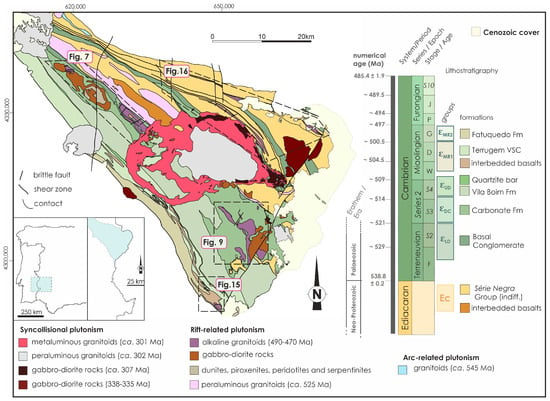
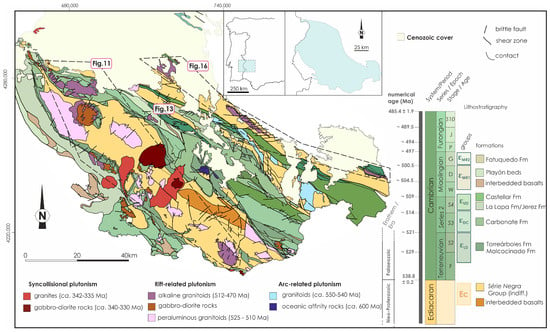

Figure 2.
Location and geological map of the Portuguese side of the study area, including the Alter do Chão–Elvas domain and a segment of the central unit/Tomar–Badajoz–Córdoba Shear Zone, adapted from [115,116,117,118,119,120,121]. References regarding ages are found throughout the text.

Figure 3.
Location and geological map of the Spanish side of the area with rift-related alkaline magmatic bodies, with segments of the Elvas–Cumbres Mayores, Sierra Albarrana, and Zafra–Alanís domains, as well as part of the central unit/Tomar–Badajoz–Córdoba Shear Zone (Central Unit). Adapted from [122]. References regarding ages are found throughout the text.
3. The Classification Method and Nomenclature
A chain classification arrangement of the OMZ alkaline rocks is proposed following the recommendations of the ISG and the NASC [3,10], further complemented with some intermediate rank terminology by the BRUCS [1] and the CLASS [4]. A diagrammatic summary is presented in Figure 4. Like the classical lithodemic classification of the ISG and the NASC (e.g., [10]), the fundamental unit is the lithodeme, i.e., (rank 4), the most basic mappable element at ca. 1:50,000 scale (either a lithotype or an unmappable rock association). Two or more lithodemes with the same class can be part of a higher rank unit but if mixed with lithostratigraphic elements (like large country rock enclaves), the term ‘complex’ should be employed. The suite (rank 2) groups alkaline magmatic rocks with the same relatable properties, i.e., the same emplacement model (igneous) or deformed lithotypes. This distinguishes the ‘intrusive’ (plutonic bodies), ‘subvolcanic’ (hypabyssal stocks and dykes), and ‘mylonite’ (the high-strain alkaline orthogneisses) suites. The ensemble of all the suites (rank 2) is a supersuite, rank 1 in the hierarchy arrangement. The term ‘assemblage’ or ‘superassemblage’ is proposed for the high-ranked classification of tectono-metamorphic units in the BRUCS [2]; however, those terms are avoided for the metamorphosed high-strain alkaline orthogneisses. All these alkaline rocks are related to the same magmatic process, although they have experienced different tectono-metamorphic paths during the Variscan Orogeny. Instead, the higher-ranked classification of these units should infer their features before deformation/recrystallization due to their petrogenetic and geochemical similarities (also proposed by Maxeiner et al. [4]).
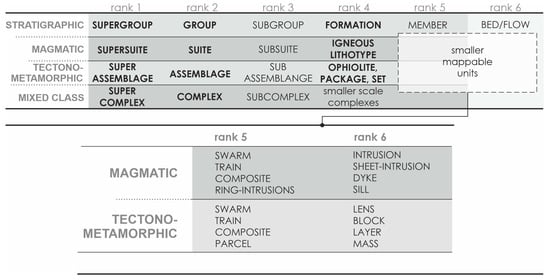
Figure 4.
Classification systems for stratigraphic, morphogenetic, and mixed-class units, partially adapted from BRUCS [2], with only some examples of rank 5 and rank 6 classifications. the terms in bold are used at a larger scale (>1:50,000). Mixed class units include more than one genetic type and have lower ranks. Ranks 5 and 6 can be used for detailed mapping (<1:50,000) and to characterize individual massifs or swarms.
The region where the OMZ alkaline igneous bodies outcrop has been informally referred to as a province, known as ‘Província Alcalina’ (e.g., [123]), as it consists of a large region with magmatic rocks exhibiting similar petrographic and geochemical features. However, the term ‘province’ will not be used as a formal rank in this classification, as suggested by Gillespie et al. [2]. Likewise, unit terms usually employed in biostratigraphic and mineralogical categories, like ‘zone’ and ‘facies’, are also avoided [2,124].
Further categorization subdivides the suites. Rank 3 (subsuite) is a division of a parent suite [4] and gathers spatially associated bodies in ‘clusters’ (or ‘centers’ if disposed around a central point [2]). This may be useful for inferring magmatic centres or associating different massifs to a broader structure and can be significant in cartographic representation at more detailed scales.
Rank 4 (the lithodeme) is the fundamental mappable rank and is equivalent in importance to the “Formation” in the lithostratigraphic system. Here, we use the main igneous lithotype (e.g., granite, syenite, and albitite), considering the higher classification ranks (1 and 2) that reflect the time of emplacement and texture, to avoid a possible misleading overlapping with other alkaline magmatic rocks spawned in other events.
Ranks 5 and 6 define the association of smaller bodies or an individual massif, classifying them according to their morphological aspects and internal complexity. These ranks should only be used for detailed mapping (Figure 5). The smaller units are placed in rank 6 (simple intrusions or lenses), and if two or more similar rank 6 bodies have a spatial relationship or a mappable lithological complexity, they become part of a rank 5 unit. A magmatic body can be a ‘pluton’ (simple or composite) and can be further characterized if it displays a distinctive shape (such as ‘ring-intrusion’ if it shows an annular form or ‘sheet-intrusion’ if it has a tabular shape) [2]. The volcanic and hypabyssal structures are either dykes or sills, and (sub)rounded bodies can also be considered plutons. The mylonite bodies have tabular/lensoidal shapes and are referred to as ‘lenses’ to distinguish the tectono-metamorphic units from similarly shaped sheet-intrusions or dykes. The close associations of small simple bodies can be defined as ‘swarms’ if the outcrops are dispersed or as ‘trains’ if they display a linear disposition (morphological concepts from [2]).
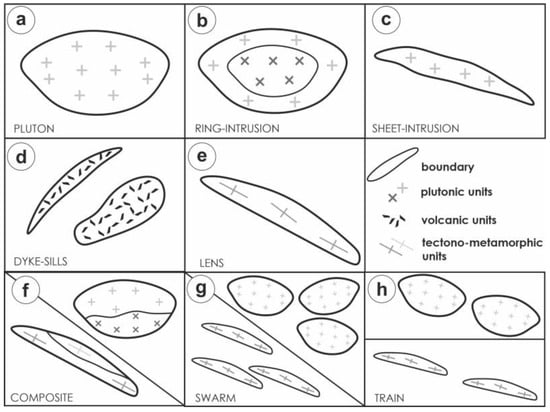
Figure 5.
Schematic representation of the mappable morphological types and designation of groups with spatially associated bodies. (a) Circular or ovoidal simple pluton; (b) ring-intrusion, a unit comprising more than one related intrusion, with an inner body bounded by a ring-shaped distinct body; (c) sheet-intrusion, represented by a tabular plutonic body with two long parallel borders much larger than the lateral dimensions; (d) dyke (left) and sill (right), correspondently near vertical or near horizontal tabular volcanic bodies; (e) lensoidal body of orthogneiss (lens); (f) composite unit, embodied by two or more lithotypes (also referred to as ‘parcel’ if the tectono-metamorphic units are contiguous at outcrop); (g) swarm, a group of two or more related dispersed units; and (h) train, a group of two or more units in a linear disposition. Schemes were made following definitions for unit terms in the hierarchy of morphogenetic units, from [2].
4. The Rheic Rift-Related Alkaline Supersuite
The Rheic rift-related Alkaline Supersuite encompasses all the magmatic and high-strained bodies emplaced along the northern margin of Gondwana suitable to be classified as alkaline. Within the Iberian Massif, this occurred during several steps within the ca. 505–470 Ma timespan ([11,12,16,19,91]), and the largest ensemble of units is found on the OMZ (Figure 6). Magmatic bodies considered for the supersuite contain modal feldspathoids, alkali amphiboles, or pyroxenes and have higher Na2O + K2O relative to CaO, even if they are geochemically classified as metaluminous [125,126,127,128]. The term ‘peralkaline’ is the geochemical term employed for rocks that show a molar ratio of Na2O + K2O)/Al2O3 > 1, while the term ‘alkaline’ is more broadly used (values for the peralkalinity index for the different massifs of the OMZ in Table 1). On this subject, the OMZ rift-related alkaline rocks are predominantly sodic (with the exceptions of some alkaline granitoids or orthogneisses), in opposition to other alkaline magmatic rocks in the region associated with collisional/post-collisional settings [60,70,129]. Regarding the mineralogical classification, all the rocks contained within this supersuite are considered miaskitic [130,131], as the only agpaitic phase described so far is aenigmatite in one intrusion, while the accessory minerals include zircon and titanite [123]. The term agpaitic was deceitfully employed to characterize some of the rocks in the supersuite as a synonym for peralkaline in previous works [123]. Agpaitic rocks are specifically defined by their unique mineral assemblages, with complex Zr- and Ti-bearing silicates, which are not necessarily present in all peralkaline rocks [130,131]. Volcanic rocks with alkaline signatures that are part of OMZ lithostratigraphic units, volcano–sedimentary complexes, or tectono-metamorphic assemblages will not be part of the supersuite. These are the Umbría-Pipeta, Playón, and Terrugem alkaline basalts [15,17,93]; the Tapadão, Peringote, Terço, and Fome weakly alkaline metarhyolites [93,123]; as well as the Ribeira de Odearce intermediate alkaline rocks [49] (in the Moura–Phyllonite Complex/Cubito–Moura unit from the Évora–Beja–Aracena domain). It is worth noting that previous works interpreted felsic volcanics in the Estremoz volcano–sedimentary complex (Estremoz–Barrancos–Hinojales domain), in the Vila Boim Formation (Alter do Chão–Elvas domain), and near Caia as alkaline rocks [118,123,132]; however, subsequent studies have demonstrated that these rocks are more accurately classified as subalkaline rhyolites emplaced in ca. 500 Ma [86,93,133].
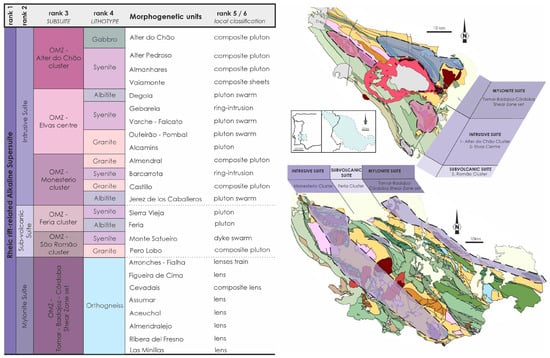
In the Iberian Massif, lithostratigraphic classifications are usually applied to each tectono-stratigraphic zone, such as the Douro–Beiras Supergroup (Douro and Beiras groups) in the Central Iberian Zone [134], or the Culm/Baixo Alentejo Flysh Group in the South Portuguese Zone [135], among others, because these units resulted from independent tectono-sedimentary and paleogeographic evolution. Despite the supersuite being herein proposed at the “zone-scale”, alkaline magmatic bodies emplaced in other zones during the Palaeozoic rift (like the ones from the lower allochthonous from the GTMZ or found elsewhere in the Variscides) are susceptible to be integrated [26,136]. Rift-related alkaline rocks from NW Iberia basal allochthonous have been previously characterized, also contrasting in composition from other subalkaline rocks emplaced during the same event [98,99,100]. It is also noteworthy to acknowledge the presence of alkaline volcanic rocks within metasedimentary sequences from units in the NW Iberia allochthonous complexes (e.g., [101,102,103,104]) and to a lesser extent in the northernmost CIZ [101].
Along the northern Gondwana margin, rift-related alkaline magmatic rocks are very scarce when compared to the Iberian Massif, as they have only been identified as alkaline orthogneisses in the Cellier Unit of the South Armorican Domain (Armorican Massif [114]) and alkaline bimodal metavolcanic rocks in the Lower Gneiss Unit of the Central Massif [111] in the Maures Massif [113], as well as in the Fichtelgebirge and Kaczawa Complex from the West Sudetes (Saxo-Thuringian Zone, Bohemian Massif, e.g., [110]).
In the proposed scheme of the alkaline supersuite, three suites can be distinguished based on shared similarities regarding their magmatic and tectono-metamorphic textural features: (i) the intrusive suite, (ii) the sub-volcanic suite, and (iii) the mylonite suite. Further subdivisions provide additional information for understanding magmatic processes and structural alignments by assessing magmatic centres or the grouping of geochemically and structurally related bodies. In the OMZ, the units from the intrusive suite can be divided into the Alter do Chão, Elvas, and Monesterio clusters/centres and the sub-volcanic suite into the São Romão and Feria clusters. As the mylonite suite comprises a set of elongated orthogneiss bodies dispersed throughout a large high-strain sinistral shear zone (the Tomar–Badajoz–Córdoba Shear Zone), there is no justification to subdivide it into clusters.


Table 1.
Range of the peralkalinity index (PI = molar Na2O + K2O/Al2O3 [125,126]) values of the felsic rocks from the OMZ part of the alkaline supersuite, from whole-rock geochemical data published in the literature. Peralkaline bodies achieve PI > 1.0.
Table 1.
Range of the peralkalinity index (PI = molar Na2O + K2O/Al2O3 [125,126]) values of the felsic rocks from the OMZ part of the alkaline supersuite, from whole-rock geochemical data published in the literature. Peralkaline bodies achieve PI > 1.0.
| Suite | Subsuite | Pluton/Swarm | Peralkalinity Index | References |
|---|---|---|---|---|
| Intrusive | OMZ—Alter do Chão cluster | Alter Pedroso | 0.85–1.27 | [123] |
| Almanhares | 0.94–1.08 | [123] | ||
| Vaiamonte | 0.77–1.05 | [123] | ||
| OMZ—Elvas centre | Degola | 0.91–0.93 | [123,137] | |
| Gebarela | 0.81–1.13 | [123,137] | ||
| Varche–Falcato | 0.62–1.46 | [123] | ||
| Outeirão-Pombal | 0.84–1.0 | [123] | ||
| Alcamins | 0.92–1.0 | [123] | ||
| OMZ—Monesterio cluster | Almendral | 0.81 | [138] | |
| Barcarrota | 0.57–1.13 | [12,138] | ||
| Castillo | 0.75–0.91 | [138,139,140] | ||
| Jerez de los Caballeros | 0.94–0.96 | [141] | ||
| Sub-volcanic | OMZ—Feria cluster | Feria | 0.79–0.93 | [138,141,142] |
| Sierra Vieja | 0.98–1.34 | [138,141,142] | ||
| OMZ- São Romão cluster | Monte Safueiro | 0.80–0.97 | [93] | |
| Pero Lobo | 0.48–0.89 | [93] | ||
| Mylonite | OMZ—TBCSZ set | Arronches–Fialha | 0.79–1.22 | [123] |
| Figueira de Cima | 0.97–1.14 | [123] | ||
| Cevadais | 0.91–1.11 | [123] | ||
| Assumar | 0.77 | [123] | ||
| Aceuchal | 0.83–1.00 | [12] | ||
| Almendralejo | 0.97–1.02 | [12] | ||
| Ribera del Fresno | 0.72–0.90 | [12,143] | ||
| Las Minillas | 0.75–0.82 | [12] |
5. The Intrusive Suite
5.1. OMZ—Alter do Chão Cluster
The Alter do Chão Cluster is located between the Alter do Chão and the Vaiamonte (Monforte) villages and comprises three plutons, variably deformed and dispersed in a NW-SE tectonic alignment (Figure 7a). From these, the Alter Pedroso composite pluton is distinguished by its exotic textural and mineralogical features (Figure 8a–d). The lithologic variability and distinct mineralogy of this pluton has been intensively described in classic petrology works [115,144,145,146,147,148,149,150] (particularly the Al-poor riebeckite, mentioned as “osannite” [145,148]), and the first sketch of a geological map was presented by Serralheiro [151], which was improved with current field works (Figure 7b). Two major intrusive units can be separated in the Alter Pedroso pluton (Figure 7b): at the NE, a unit composed of coarse-grained leucocratic syenites with rare riebeckite (Figure 8a), and at the SW, a unit characterized by mesocratic fine-grained syenites with aegirine and riebeckite phenocrysts (classically referred to as “lusitanite” [146], Figure 8b), or banded riebeckite syenites. The SW mesocratic syenite unit often shows pegmatoid varieties (Figure 8c), which range from hololeucocratic (albite-dominant) rocks to tabular melanocratic bodies essentially composed of riebeckite megacrystals (anciently referred to as “osannite-hornblendite” [145] and after as “pedrosite” [115], Figure 8d). Geochronological studies determined zircon U/Pb emplacement ages of 482 ± 16 Ma [92] for this pluton. Towards the NE, small sinistral shear zones are commonly found (Figure 7b), culminating with the development of gneissic textures in the northernmost limit of the body.
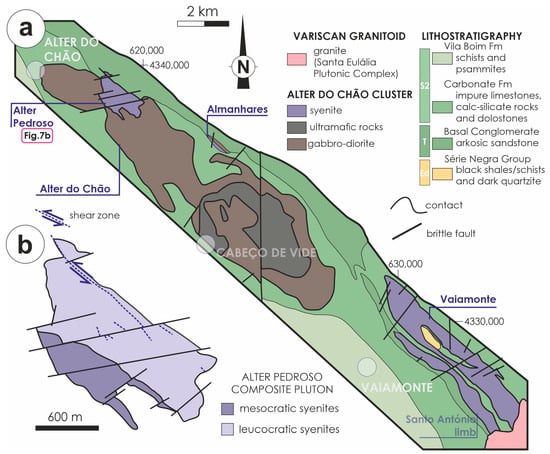
Figure 7.
(a) Regional lithological map of the elongated Alter do Chão cluster (rank 3 unit), partially adapted from [149]. The southwestern body of Vaiamonte (separated by a stripe of rocks from the Carbonate Fm) is the Santo António limb. (b) Detailed geological map of the major different units of the Alter Pedroso composite pluton (rank 5 unit), with the two distinct syenite intrusions (rank 6 units).
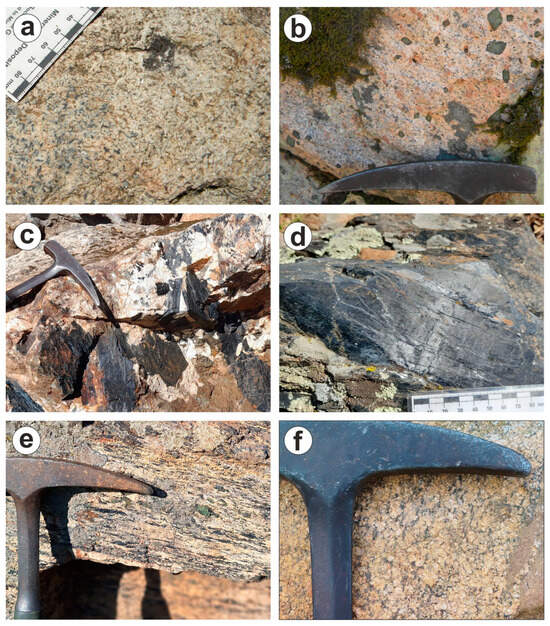
Figure 8.
Representative textural aspects of rocks from the Alter do Chão Cluster. Rocks from the intrusions of the Alter Pedroso pluton: (a) Leucocratic syenite. (b) Mesocratic aegirine-bearing syenite (“lusitanite” [146]). (c) Pematoid syenite with riebeckite megacrystals. (d) A pegmatoid rock solely composed of riebeckite (“pedrosite” [115]). Sheared intrusions from the Vaiamonte sheet-complex: (e) strongly foliated mesocratic syenite and (f) weakly foliated leucocratic syenite.
In Almanhares (to the east), a very narrow nepheline syenite occurs contiguous to a small metamafic body. This is the only known occurrence of a nepheline syenite in the Alter do Chão–Elvas Domain and in the equivalent Spanish parts; another point of distinction of this body is the presence of sodalite associated with nepheline and taramite amphibole [123].
To the southeast, the Vaiamonte body consists of folded sheet-like intrusions mixed with large portions of Ediacaran–Cambrian country rocks, following the NW-SE regional trend. The southwest tabular intrusion (referred to as “Santo António” [123,149]) is a weakly deformed leuco-mesocratic syenite interpreted to be the limb of a large syncline structure, according to new geological mapping surveys. To the north, the observed structure shows a transition from a synform to an antiform, overlaid by rocks from the Series 2 Carbonate Formation. The antiform part of the body is composed of variably deformed intrusions that range from hololeucocratic to mesocratic syenites or quartz syenites and rare sheared pegmatoid syenites (Figure 8e,f). The core of the antiform is characterized by a succession of siliciclastic and metavolcanic rocks, similar to the Ediacaran–Terreneuvian successions.
An elongated mostly mafic segmented pluton outcrops between the Alter do Chão and Cabeço de Vide villages. It is composed of weakly alkaline kaersutite gabbros (average Na2O + K2O = 2.07%, up to 3.33% [123,152]), diorites, and ultramafic rocks (pyroxenites, dunites, and peridotites, commonly serpentinized). The presence of kaersutite supports this mafic body in the Alkaline Supersuite [126]. The geochronology studies of the gabbros yielded very poorly constrained K/Ar ages of ca 501–432 Ma [153], which nonetheless fall within the emplacement time range of the alkaline rocks. Field observations conclude that the Alter Pedroso pluton intrudes the gabbro, as also inferred by Teixeira et al. [149].
5.2. OMZ—Elvas Centre
In the Elvas region, the alkaline and peralkaline plutonic bodies are majorly restricted to the Series 2 Carbonate Formation, intruding rocks from this succession, and they are also spatially associated with tholeiitic gabbro–diorite rocks [123] (Figure 9a). Alkaline rocks from this group also show distinctive textural features (Figure 10). Within this cluster, the southernmost Alcamins body, a NW-SE elongated monotonous hedembergite-bearing granite (Figure 10a) [119], is the only one that contacts not only rocks from the Carbonate Formation but also from the basal Cambrian succession of the Ediacaran Série Negra Group outcropping in the Torre de Cabedal structure [115,119,154].

Figure 9.
(a) Regional lithological map of the Elvas Centre (rank 3 unit, adapted from [119,149]), with the tabular and sub-circular/ovoidal plutonic alkaline bodies distributed asymmetrically in a central point and stretched following a NW-SE trend. The large fault separating Varche and Falcato intrusions corresponds to the Messejana fault (mentioned in the text). (b) Detailed geological map of the concentric zonation of the Gebarela ring intrusion (a slightly similar zonation has previously been proposed in [137]). In this region, the pluton swarms and the ring intrusion are classified at rank 5, while the individual plutons and each unit from the Gebarela body are rank 6.
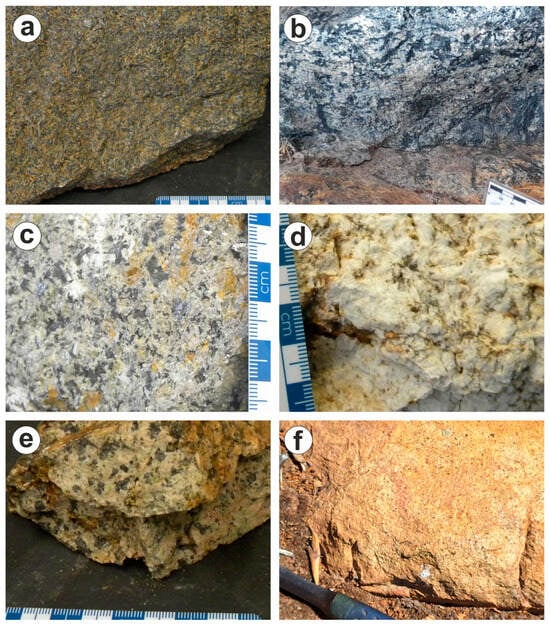
Figure 10.
Macroscopic features of rocks from the Elvas Centre: (a) Hedembergite-bearing granitoid from Alcamins, (b) Mesocratic syenite from Varche, (c) Mesocratic syenite from Falcato, (d) Albitite from the inner Gebarela core, (e) Mesocratic syenite from the Gebarela ring intrusion, (f) Perthosite from the Degola-folded pluton.
The outcrops of the Varche and Falcato pluton also occur in the south of the gabbro, intruding the carbonate succession. Rocks from this pluton correspond to distinct types of mesocratic syenites (Figure 10b,c) and are characterized by high peralkalinity index values (PI up to 1.46) and the presence of aenigmatite (though scarce) [123]. Both Varche and Falcato are considered the same pluton that was dismembered by the late-Variscan NE-SW left-lateral Messejana fault [149]. Geochronological data determined a crystallization age of 490 ± 4 Ma for these rocks [91]. Contiguous to the Varche–Falcato outcrops (at the west), the elongated bodies of Pombal and Outeirão are alkaline leucocratic granites (e.g., [123]) that are also separated by a NE-SW discontinuity and likewise classified as a pluton swarm; the Outeirão segment also comprises associated marginal mafic rocks [119].
The Gebarela composite body (NE from the Outeirão-Pombal pluton swarm) consists of a small tabular and concentrically zoned peralkaline pluton (Figure 9b) [123], composed of albitite rocks in the inner domain (Figure 10d) and an external ring of mesocratic garnet-bearing syenites (Figure 10e). Recent geological mapping surveys (Figure 9b) confirm the lithological zoning proposed by Pinto Coelho et al. [137]. Despite a few small outcrops of country rock xenoliths within the inner albitite unit, these do not represent a significant part of the body, and therefore, the appropriate designation should be ‘ring-intrusion’.
Finally, in the northernmost part, two very small subcircular perthosite bodies (a variety of albitite, Figure 10f) crop out in Degola, with a N-S alignment (Degola-Taipas, [119]), representing the two limbs of a folded pluton (according to new field mapping surveys).
5.3. OMZ—Monesterio Cluster
This cluster encompasses the alkaline plutonic rocks that are spatially associated with the Olivenza–Monesterio Anticline (Figure 11a). These include not only the bodies located within the core of the anticline (Barcarrota and Castillo) but also those emplaced along its northeastern and southwestern limbs, corresponding to the Zafra–Alanís and Elvas–Cumbres Mayores domains (Figure 1) [24,25]. These bodies do not generally have well-marked elongated shape when compared to the Alter do Chão–Elvas domain (Figure 7a and Figure 9a), which show the result of deformation processes associated with the subduction and collisional phases of the Variscan Orogeny during Devonian–Carboniferous times.
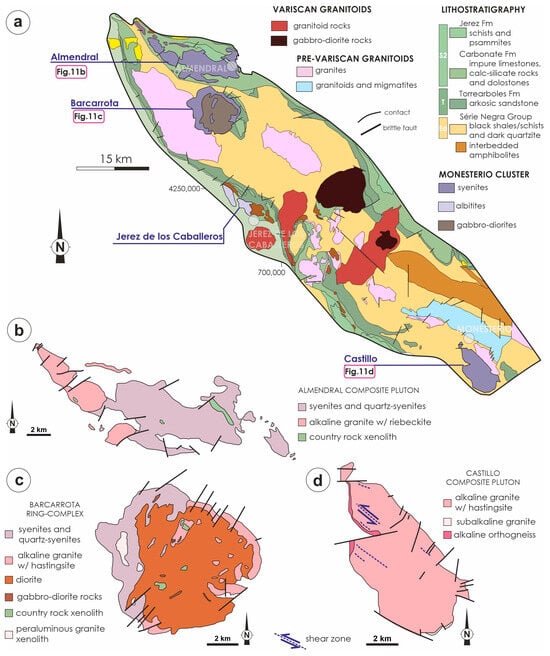
Figure 11.
(a) Regional lithological map of the Monesterio cluster (rank 3), adapted from [122,155,156,157,158]. (b) Detailed map of the Almendral composite pluton, comprising syenite/quartzsyenite and granite intrusions, from [159]. (c) The Barcarrota ring complex, composed of syenites and quartz syenites and alkaline granite ring intrusions, around the central mafic body [160,161]. (d) Zonation of the Castillo composite pluton, with subalkaline granites to the southeast, the main alkaline granite body, and the orthogneiss northwest rim, from [162].
In the northeast limb, the Almendral body is represented by a composite WNW-ESE slightly elongated pluton that majorly intrudes carbonate formation [158]. This pluton is composed of alkaline granites and syenites/quartz syenites, characterized by the presence of sodic amphiboles [158,159], as well as minor roof pendants with carbonate rocks [163]. The detailed map (Figure 11b; [159]) shows that the alkaline granites are majorly restricted to the western side of the pluton whereas syenites of variable grain size crop outs within the central and eastern parts. Radiometric K-Ar dating of the syenites of Almendral yielded ages of 450 ± 12 and 481 ± 10 Ma [164], with the latter being considered the closest age to crystallization by comparison to the other alkaline plutonic bodies intruding the Carbonate Formation (e.g., [91]). Small outcrops of small-grained syenites still occur between Olivenza and Valverde de Leganés [138], assumed as part of the Almendral body.
In the southern limb of the Olivenza–Monesterio Anticline (near the municipality of Jerez de los Caballeros), a swarm of albitites intrudes the Carbonate Formation and the Upper Detrital succession. These albitites (Figure 12a) are spatially associated with tholeiitic gabbros but are interpreted to have been emplaced at a later stage [94]. The relative timing of emplacement suggests that the gabbros postdate the late Series 2 Miaolingian volcanics, while the albitites postdate the gabbros. However, no radiometric data for these albitites are currently available to confirm the crystallization ages.
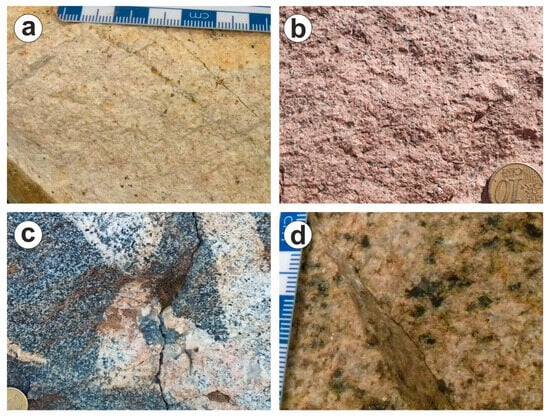
Figure 12.
Macroscopic aspects of the rocks from the Monesterio cluster: (a) albitite from the Jerez de los Caballeros swarm. (b) Leucocratic quartz syenites and (c) gabbro–diorite rocks from the Barcarrota ring complex. (d) Hastingsite-bearing granite from the Castillo pluton.
Two large plutons occur in the core of the Olivenza–Monesterio Anticline. The Barcarrota pluton (Figure 11c and Figure 12b,c) is a subrounded composite pluton characterized by syenite and granite ring intrusions around a major alkaline gabbro–diorite core, enveloping large portions of country rock xenoliths (carbonate roof pendants and portions of the Táliga peraluminous granite) [160,161,164]. It intrudes the metassedimentary rocks of the Série Negra Group, as well as a part of the Cambrian succession and the Táliga granite. The alkaline character of the different intrusions (PI reaching 0.96, Table 1) has been previously reported [160]. The geochemical data suggest a genetic relationship between the different lithotypes of this pluton, from the mafic-intermediate terms to the more evolved felsic rocks [160]. The internal magmatic structure and distinct large country rock xenoliths suggest that the Barcarrota pluton should be considered as a ‘ring-complex’. Geochronology studies determined the emplacement ages of this body of around 502 Ma (U/Pb methods yielded ca. 501 Ma for the granites and ca. 503 Ma for the diorite core [12], K/Ar methods yielded 505 ± 5 Ma and Rb/Sr calculated isochron yielded 508 ± 1.4 Ma [165]). The Castillo composite pluton intrudes rocks from the Série Negra Group and the Culebrín peraluminous granite, located near Monesterio (Figure 11d). In addition to a very narrow southern margin that comprises a subalkaline granite, the Castillo central rocks consist of hastingsite-bearing alkaline granites that are variably deformed (Figure 8d) [11,139,162]. The intensity of shear deformation increases towards the northwestern part, where orthogneisses are found [139,162] (Figure 11d). The radiometric data yielded crystallization ages of 502 ± 8 Ma for the Castillo composite pluton [11].
6. The Sub-Volcanic Suite
The OMZ part of the Sub-Volcanic Suite is composed of shallow-level intrusions of alkaline rocks, primarily restricted to late Series 2 Miaolingian successions of the southernmost Alter do Chão Elvas domain (in Portugal) and of the Zafra–Alanís domain, located in the northern limb of the Olivenza–Monesterio Anticline (in Spain).
6.1. OMZ—Feria Cluster
The Feria Cluster includes small hypabyssal bodies intruding the Carbonate, Vallehondo, and Playón formations during the Cambrian (Figure 13).
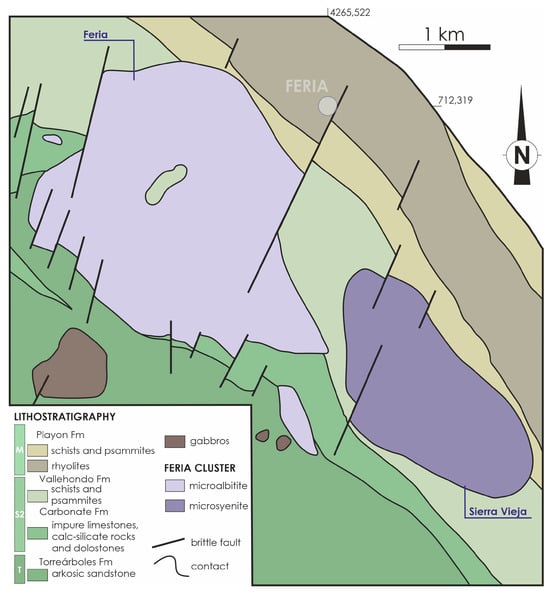
Figure 13.
Lithological map of the Feria cluster, showing the Feria albitites and the Sierra Vieja hypabyssal syenite body, from [142].
Southwest of the municipality of Feria, at least three fine-grained albitite and microsyenite bodies outcrop were found (Figure 14a), intersecting all rocks from the Cambrian succession [141,142,156]. Zircon U-Pb studies determined crystallization ages of 514 ± 3 Ma [16], which is not consistent with the age of some intruded lithostratigraphic rocks (lower Miaolingian). To the southeast, the Sierra Vieja body is a homogenous alkaline granitoid stock hosting sodic pyroxene and amphibole phenocrysts within a fine-grained (<2 mm) quartz–feldspathic groundmass (Figure 14b) and is thus considered a hypabyssal pluton (though in the literature, it is often named granite, e.g., [16,90]). It exhibits peralkaline geochemical values (PI up to 1.28, Table 1) and yields zircon crystallization ages of 517.6 ± 4 Ma [16], which is not compatible with the age of the intruded late Series 2 Miaolingian country rocks [94,142]. Also, Sánchez-García et al. [16] reported that the analyzed samples only contained angular zircon fragments with patchy irregular zonation, weak luminescence, and a high degree of lead loss. This pluton should at least yield ages from the uppermost Series 2, or most likely Miaolingian.
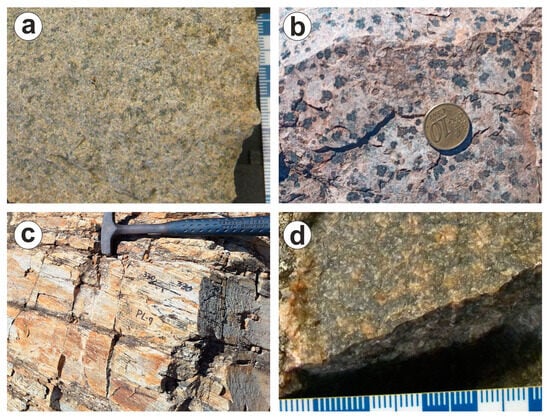
Figure 14.
Rocks from the Sub-Volcanic Suite: (a) macroscopic features of the Feria and (b) the Sierra Vieja rocks. Rocks from the Pero Lobo pluton: (c) sheared microgranite from the southwestern intrusion and (d) quartz syenite from the northwestern intrusion.
6.2. OMZ—São Romão Cluster
The São Romão Cluster (Figure 15a) is located in the vicinity of São Romão and is composed of alkaline subvolcanic bodies that intrude Miaolingian successions, including the alkaline mafic rocks from the Terrugem volcano–sedimentary complex (Terrugem VSC) [93,166]. There are no geochronological data for the rocks of this cluster, but based on biostratigraphic constraints regarding the lateral equivalents of the intruded Terrugem VSC (i.e., the Playón Formation; [54]), upper Miaolingian ages (late Drumian–Guzhangian) are inferred. The Monte Safueiro volcanics consist of scattered melanocratic trachytic and microsyenitic dykes outcropping at the top of the Miaolingian successions [93,119,166], arranged as a dyke swarm. The Pero Lobo Massif is a composite body with two granitoid units: a microgranite with a similar texture to the Monte Safueiro dykes and dark quartz-syenites (Figure 14d), which are possibly considered intrusive [93]. Structurally, the Pero Lobo body is sheared (mostly in their southernmost domains; Figure 14c and Figure 15b), showing an ellipsoidal shape and highlighting a primary horizontal stratiform layering with the microgranite at the top and the quartz-syenites at the bottom (Figure 15b).
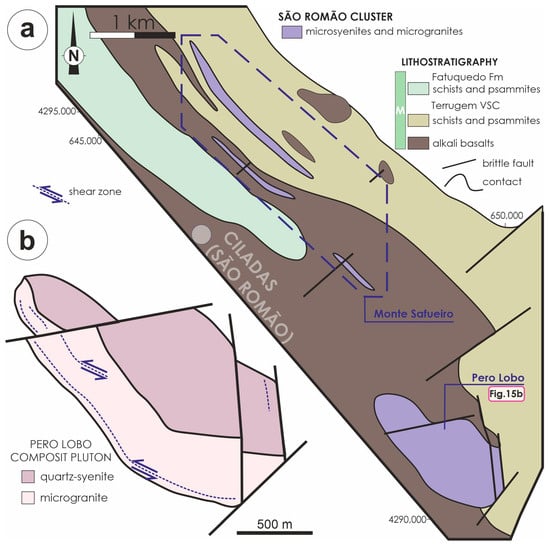
Figure 15.
(a) Geological map of the region of the rank 5 Monte Safueiro trachytic/microsyenite dyke swarm and the Pero Lobo body (São Romão Cluster, Sub-volcanic Suite), intruding the Miaolingian succession, adapted from [119,120]. (b) Lithological map of the Pero Lobo petrographic zoning (alkali microgranite and quartz syenite). Each individual “unnamed” dyke from the Monte Safueiro swarm and intrusion type from the Pero Lobo body is a rank 6 unit.
7. The Mylonite Suite
OMZ—Tomar–Badajoz–Córdoba Set
The TBCSZ is a major tectonic structure in the Iberian Massif developed during the Variscan Orogeny, and it consists of a large high-strain sinistral shear zone with intense ductile deformation, showing transcurrent tectonics under distinct metamorphic grades [24,28,167,168,169]. The lithological units are characterized by dominant left-lateral kinematics with strain partitioning, showing intense tectonic foliation and lineation, in which the lithological contacts serve as zones of weakness and are reactivated as shear zones.
Along the Tomar–Badajoz–Córdoba Shear Zone, an alignment of alkaline and peralkaline orthogneisses crops out as lensoidal bodies with different sizes from the region of Assumar (Arronches) to Granja de Torrehermosa (Azuaga) (Figure 16a,b). All orthogneiss lenses follow the regional WNW-ESE to NW-SE trend. The fact that these rocks experienced high-strain deformation and metamorphic recrystallization makes them tectono-metamorphic units; however, we propose a grouping based on the magmatic nature of the protolith. In Assumar, a very narrow lensoidal body (Figure 16c) of a reddish hastingsite-bearing sheared granite (with discrete augen tendencies, Figure 17a) intrudes Cambrian carbonates, e.g., [123]. This is the only body from this set that intrudes the Cambrian units, and it is the one with the lowest PI (ca. 0.77, Table 1).
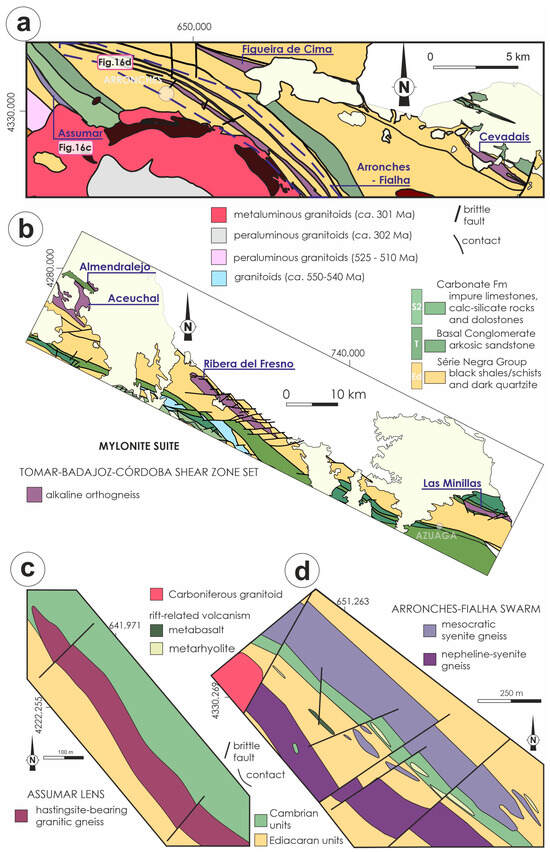
Figure 16.
Localization of the bodies from the Mylonite Suite within the Central Unit in (a) the Portuguese segment and (b) the Spanish segment. Lithological maps of different alkaline orthogneisses: (c) the lens of Assumar and (d) lens from the Arronches–Fialha swarm.
Slightly to the east, disperse alkaline orthogneisses from the Arronches–Fialha swarm (Figure 16d) crop out intruding Ediacaran rocks. The lithotypes vary from nepheline syenites to hastingsite-bearing granites [123,137,149] (Figure 17b) and have a wide range of PI values (from 0.79 to 1.22, Table 1). The textural features found in the different bodies (with S and S-L fabrics) can be ascribed to different primary textural and mineralogical properties that presumably underwent different conditions of tectono-metamorphic recrystallization [137,170]. One of the lenses from the Arronches–Fialha swarm yielded protolith U/Pb ages of ca. 470 ± 3 Ma [91]. North of this swarm, the Figueira de Cima mesocratic syenite gneiss (initially described by [115]), with katophorite and richterite amphiboles [123], occurs as an elongated WNW-ESE lens.
The Cevadais composite lens (Ouguela region, Campo Maior) comprises two contiguous sheared syenite bodies that are interpreted as a folded structure [90]. A structural map has been presented by Pereira et al. [167]. Two different strongly sheared facies have been described in this body [123,149,171,172], corresponding to riebeckite- and aegirine-bearing syenite gneiss with S-L or L-dominant fabrics (regionally named “cevadaisite” [115,149], Figure 17c), as well as a narrow sodalite-bearing nepheline syenite lens (classically referred to as “ouguelite” [171]), with no riebeckite [149]. The Cevadais syenite yielded crystallization ages of 479 ± 3 [91].
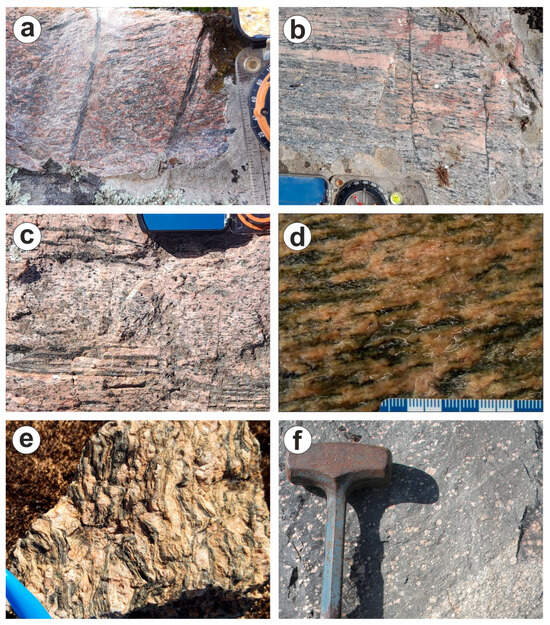

Figure 17.
Distinct fabrics from the lensoidal body characteristics of the Mylonite Suite: (a) hastingsite-bearing granitic gneiss, (b) nepheline-syenite gneiss from the Arronches–Fialha swarm (Fialha area), (c) Riebeckite- and aegirine-bearing syenite gneiss from Cevadais (“cevadaisite” [115,171]), (d) Almendralejo hastingsite-bearing syenite gneiss, (e) granitic gneiss from Ribera del Fresno, and (f) granitic gneiss from Las Minillas.
In Almendralejo (near Badajoz, Spain), two parallel lenses crop out, both with S-L fabric and following the NW-SE regional trend partially covered by Cenozoic sediments. The southwest Aceuchal lens is a reddish hastingsite-bearing granitic gneiss (with scarce riebeckite) emplaced in ca. 477 Ma [12]. The Almendralejo body (Figure 17d) is described as riebeckite-bearing aegirine–augite orthogneiss, practically contemporaneous with the Aceuchal body, yielding zircon U/Pb ages of ca. 475 Ma [12].
The Ribera del Fresno lens is a coarse-grained granitic augen gneiss (Figure 17e) with a mildly alkaline composition (PI up to 0.90, Table 1, previously referred to as “subaluminous” [143]). Geochronological studies on the protolith yielded zircon U/Pb ages of 476 ± 7 Ma [19]. The Las Minillas lens is located to the southeast of Ribera del Fresno (Azuaga) and consists of a variably foliated mesocratic augen gneiss (Figure 17f) with a granitic composition. This body is compositionally subalkaline (with mild PI values of 0.75–0.82, Table 1), and no alkali minerals have yet been described in its assemblage [12]; however, the resemblances with the more documented Ribera del Fresno body suggest that they could have similar genetic evolution and protolith compositions. Previous geochronological studies yielded very poorly constrained ages (556 +159/−67 Ma [12]), but posteriorly determined crystallization ages of ca. 474 Ma (Schafer, in [173]).
8. Final Remarks
The classification method presented herein is a ranked system that was applied to the alkaline magmatic rocks of the OMZ (SW Iberia), designed to improve geological mapping across scales and strengthen regional and continental correlations. Likewise, the clear delineation of the extent of the supersuite is also prone to allow for inferences on the rift-related alkaline magmatism, areas with more concentrated magmatic activity and described as high-strained bodies. Ranks 1 to 4 should be useful for geological mapping and classifying rocks for regional geological studies, while ranks 5 and 6 are more dedicated for detail mapping. The location of the suites may provide clues for the paleogeography and configuration of the Cambrian crust and magmatic activity on the OMZ, posteriorly parallelized to the regional northwest–southeast trend related with the Variscan Orogeny.
It is noticeable that the sub-volcanic suite (Feria and S. Romão clusters) is inserted in the upper levels, within mostly Miaolingian country rocks, while the rest of the bodies (intrusive and mylonite suites) are emplaced within the Ediacaran–Cambrian Series 2 sequences. The plutons in the core of the Olivenza–Monesterio Anticline yielded the oldest ages, while the rocks from the mylonite suite are the most recent. The alkaline orthogneisses from the mylonite suite exhibit the youngest crystallization ages. The clusters highlight specific associations of co-magmatic plutons that may infer ancient magmatic centres (as in the case of Elvas) or encompass high-strain bodies in large shear zones.
All bodies could be mapped at a scale >1:50,000 according to the representative lithotypes (rank 4). The smaller rank classes (ranks 5 and 6) provide information on the internal architecture or lithofacies of each pluton or specific rock dispositions. Overall features (mineralogical and geochemical) show that the degree of alkalinity of rocks from the supersuite in all the domains increases from the southeast to the northwest and varies with the age and size of each pluton. The nepheline syenites (even if deformed) and albitites consist of smaller plutons, while syenites and syenite gneisses show a moderate size, and the quartz syenites, granites, and gabbro–diorites show the largest volume. Despite this work providing a regional-scale overview on the Cambro–Ordovician OMZ alkaline rocks, the Rheic-related alkaline bodies from the other northern Gondwana regions—from the Iberian GTMZ to the Armorican, Central, and Bohemian Massifs—could be integrated in this ranked classification scheme for the alkaline magmatic bodies to better constrain the rift-related alkaline magmatism at the North Gondwana margin terrane scale.
Author Contributions
Conceptualization: J.R. and N.M.; Methodology: J.R., N.M. and M.S.; Formal analysis and investigation: J.R., N.M. and P.N. Writing—original draft preparation: J.R.; Writing—review and editing: All authors. Funding Acquisition: P.N. and N.M.; Supervision: N.M., P.N., D.d.O. and L.E. All authors have read and agreed to the published version of the manuscript.
Funding
J.R. recognizes Fundação para a Ciência e Tecnologia, I.P. (FCT), for their support through the doctoral grant (UI/BD/150937/2021, https://doi.org/10.54499/UI/BD/150937/2021) and the Society of Economic Geologists for the support through the Hugh McKinstry Fund (SRG 21-46 award). M.S. also recognizes the grant for the PhD thesis with the reference PRT/BD/153588/2021, financed by FCT and promoted by Portuguese Space Agency. J.R., N.M., M.S., and P.N. acknowledge the funds through FCT in the framework of the UIDB/04683 and UIDP/04683—Instituto de Ciências da Terra and the funding through the project ZOM3D (Modelos Metalogénicos 3D da Zona de Ossa-Morena—Valorização dos Recursos Minerais do Alentejo), with reference ALT20-03-0145-FEDER-000028, funded by Alentejo 2020 (Regional Operational Programme of Alentejo) through the FEDER/FSE/FEEI.
Data Availability Statement
Data are contained within the article.
Acknowledgments
This work is a contribution to the Special Issue “Petrographic, Geophysical, Geochemical and Geochronological Study of Magma and Magmatism in the Iberian Peninsula and Archipelagos”, and we thank the guest editors Enrique Merino Martínez and Helena Sant’Ovaia for the interest provided. We also thank the suggestions provided by the anonymous reviewers.
Conflicts of Interest
The authors declare no competing interests relevant to the content of this article. The funders had no role in the design of the study; in the collection, analyses, or interpretation of data; in the writing of the manuscript; or in the decision to publish the results.
References
- Gillespie, M.; Stephenson, D.; Millward, D. BGS Classification of Lithodemic Units: Proposals for Classifying Units of Intrusive Rock. In British Geological Survey Research Report RR/08/05; British Geological Survey: Nottingham, UK, 2008; Volume 31. [Google Scholar]
- Gillespie, M.R.; Leslie, A.G. BRUCS: A New System for Classifying and Naming Mappable Rock Units. J. Geol. Soc. Lond. 2021, 178, jgs2020-212. [Google Scholar] [CrossRef]
- Hattin, D.E. Lithodemes, Suites, Supersuites, and Complexes: Intrusive, Metamorphic, and Genetically Mixed Assemblages of Rocks Now Embraced by North American Code of Stratigraphic Nomenclature. Precambrian. Res. 1991, 50, 355–357. [Google Scholar] [CrossRef]
- Maxeiner, R.O.; Bosman, S.A.; Card, C.D.; Marsh, A.; Morelli, R.M.; Couëslan, C.; Martins, T.; Reid, K.; Easton, R.M.; Knox, B.; et al. Classifying Intrusive and Strongly Metamorphosed Rock Units: CLASS—A Cooperative Lithodemic and Stratigraphic System. Can. J. Earth Sci. 2024, 61, 1014–1042. [Google Scholar] [CrossRef]
- Champion, D.C.; Chappell, B.W. Petrogenesis of Felsic I-Type Granites: An Example from Northern Queensland. Earth Environ. Sci. Trans. R. Soc. Edinb. 1992, 83, 115–126. [Google Scholar] [CrossRef]
- Beard, C.D.; Goodenough, K.M.; Borst, A.M.; Wall, F.; Siegfried, P.R.; Deady, E.A.; Pohl, C.; Hutchison, W.; Finch, A.A.; Walter, B.F.; et al. Alkaline-Silicate REE-HFSE Systems. Economic. Geol. 2023, 118, 177–208. [Google Scholar] [CrossRef]
- Simonetti, M.; Pieruccioni, D.; Carosi, R.; Montomoli, C.; Iaccarino, S.; Zucchi, M. A Review of Criteria, Methods, and Standards for Mapping Crystalline Terrains: Integrating Field Geology and Analytical Data. Ital. J. Earth Sci. 2024, 143, 1–29. [Google Scholar] [CrossRef]
- White, A.J.R.; Allen, C.M.; Beams, S.D.; Carr, P.F.; Champion, D.C.; Chappell, B.W.; Wyborn, D.; Wyborn, L.A.I. Granite Suites and Supersuites of Eastern Australia. Aust. J. Earth Sci. 2001, 48, 515–530. [Google Scholar] [CrossRef]
- Wyborn, D.; Turner, B.S.; Chappell, B.W. The Boggy Plain Supersuite: A Distinctive Belt of I-type Igneous Rocks of Potential Economic Significance in the Lachlan Fold Belt. Aust. J. Earth Sci. 1987, 34, 21–43. [Google Scholar] [CrossRef]
- North American Commission on Stratigraphic Nomenclature. NACSN North American Stratigraphic Code. Stratigraphy 2021, 18, 153–154. [Google Scholar] [CrossRef]
- Salman, K. The Timing of the Cadomian and Variscan Cycles in the Ossa-Morena Zone, SW Iberia: Granitic Magmatism from Subduction to Extension Cronología de Los Ciclos Cadomiense y Varisco En La Zona de Ossa Morena, SO de Iberia: Magmatismo Granítico Desde La Subducción a La Extensión. J. Iber. Geol. 2004, 30, 119–132. [Google Scholar]
- Ochsner, A. U-Pb Geochronology of the Upper-Proterozoic—Lower Palaeozoic Geodynamic Evolution in the Ossa-Morena Zone (SW Iberia): Constraints on the Timing of the Cadomian Orogeny. Ph.D. Thesis, ETH, Zurich, Switzerland, 1993. [Google Scholar]
- de Oliveira, D.; Poujol, M.; Robb, L.J. U-Pb Geochronology for the Barreiros Tectonised Granitoids and Arronches Migmatitic Gneisses—Tomar Cordoba Shear Zone, East Central Portugal. Rev. Soc. Geológica España 2002, 15, 105–112. [Google Scholar]
- Pereira, M.F.; Chichorro, M.; Solá, A.R.; Silva, J.B.; Sánchez-García, T.; Bellido, F. Tracing the Cadomian Magmatism with Detrital/Inherited Zircon Ages by in-Situ U-Pb SHRIMP Geochronology (Ossa-Morena Zone, SW Iberian Massif). Lithos 2011, 123, 204–217. [Google Scholar] [CrossRef]
- Sánchez-García, T.; Bellido, F.; Quesada, C. Geodynamic Setting and Geochemical Signatures of Cambrian-Ordovician Rift-Related Igneous Rocks (Ossa-Morena Zone, SW Iberia). Tectonophysics 2003, 365, 233–255. [Google Scholar] [CrossRef]
- Sánchez-García, T.; Quesada, C.; Bellido, F.; Dunning, G.R.; González del Tánago, J. Two-Step Magma Flooding of the Upper Crust during Rifting: The Early Paleozoic of the Ossa Morena Zone (SW Iberia). Tectonophysics 2008, 461, 72–90. [Google Scholar] [CrossRef]
- Sánchez-García, T.; Bellido, F.; Pereira, M.F.; Chichorro, M.; Quesada, C.; Pin, C.; Silva, J.B. Rift-Related Volcanism Predating the Birth of the Rheic Ocean (Ossa-Morena Zone, SW Iberia). Gondwana Res. 2010, 17, 392–407. [Google Scholar] [CrossRef]
- Sánchez-García, T.; Pereira, M.F.; Bellido, F.; Chichorro, M.; Silva, J.B.; Valverde-Vaquero, P.; Pin, C.; Solá, A.R. Early Cambrian Granitoids of North Gondwana Margin in the Transition from a Convergent Setting to Intra-Continental Rifting (Ossa-Morena Zone, SW Iberia). Int. J. Earth Sci. 2014, 103, 1203–1218. [Google Scholar] [CrossRef]
- Casado, B.O. Geochronological Studies of the Pre-Mesozoic Basement of the Iberian Massif: The Ossa-Morena Zone and the Allochthonous Complexes within the Central Iberian Zone. Ph.D. Thesis, ETH, Zurich, Switzerland, 1998. [Google Scholar]
- Pereira, M.F.; Gama, C.; Dias da Silva, I.; Fuenlabrada, J.M.; El Houicha, M. Cadomian Arc Recycling along the Northern Gondwana Margin: Source-Inherited Composition of Miaolingian Rift-Related Rhyolitic Rocks (Ossa-Morena Zone, SW Iberia). J. Afr. Earth Sci. 2023, 201, 104887. [Google Scholar] [CrossRef]
- Goodenough, K.M.; Schilling, J.; Jonsson, E.; Kalvig, P.; Charles, N.; Tuduri, J.; Deady, E.A.; Sadeghi, M.; Schiellerup, H.; Müller, A.; et al. Europe’s Rare Earth Element Resource Potential: An Overview of REE Metallogenetic Provinces and Their Geodynamic Setting. Ore Geol. Rev. 2016, 72, 838–856. [Google Scholar] [CrossRef]
- Julivert, M.; Fontboté, J.M.; Ribeiro, A.; Conde, L. Mapa Tectónico de La Península Ibérica y Baleares. Escala 1: 1.000.000. Mem. Explicativa. Inst. Geológico Y Min. España Madr. 1974, 1–113. Available online: https://fundacioncajasegovia.es/producto/mapa-tectonico-de-la-peninsula-y-baleares-escala-11-000-000/ (accessed on 26 December 2024).
- Lotze, F. Zur gliederung der Varisziden der Iberischen meseta. Geotecktonische Forschungen 1945, 6, 78–92. [Google Scholar]
- Apalategui, O.; Eguiluz, L.; Quesada, C. Structure of the Ossa-Morena Zone. In Pre-Mesozoic Geology of Iberia; Dallmeyer, R.D., Martínez-García, E., Eds.; Springer: Heidelberg, Germany, 1990; pp. 280–291. [Google Scholar]
- Robardet, M.; Gutiérrez-Marco, J.C. The Ordovician, Silurian and Devonian Sedimentary Rocks of the Ossa-Morena Zone (SW Iberian Peninsula, Spain); Universidad Complutense de Madrid: Madrid, Spain, 2004; Volume 30. [Google Scholar]
- Díez Fernández, R.; Arenas, R. The Late Devonian Variscan Suture of the Iberian Massif: A Correlation of High-Pressure Belts in NW and SW Iberia. Tectonophysics 2015, 654, 96–100. [Google Scholar] [CrossRef]
- Oliveira, J.T.; Oliveira, V.; Piçarra, F. Traços Gerais Da Evoluçao Tectono-Estratigráfica Da Zona de Ossa-Morena, Em Portugal. Cuad. Lab. Xeolóxico Laxe 1991, 16, 221–250. [Google Scholar]
- Burg, J.P.; Iglesias, M.; Laurent, P.; Matte, P.; Ribeiro, A. Variscan Intracontinental Deformation: The Coimbra—Cordoba Shear Zone (SW Iberian Peninsula). Tectonophysics 1981, 78, 161–177. [Google Scholar] [CrossRef]
- Ribeiro, A.; Munhá, J.; Dias, R.; Mateus, A.; Pereira, E.; Ribeiro, L.; Fonseca, P.; Araújo, A.; Oliveira, T.; Romão, J.; et al. Geodynamic Evolution of the SW Europe Variscides. Tectonics 2007, 26, TC6009. [Google Scholar] [CrossRef]
- Arenas, R.; Díez Fernández, R.; Sánchez Martínez, S.; Gerdes, A.; Fernández-Suárez, J.; Albert, R. Two-Stage Collision: Exploring the Birth of Pangea in the Variscan Terranes. Gondwana Res. 2014, 25, 756–763. [Google Scholar] [CrossRef]
- Dias, R.; Ribeiro, A.; Romão, J.; Coke, C.; Moreira, N. A Review of the Arcuate Structures in the Iberian Variscides; Constraints and Genetic Models. Tectonophysics 2016, 681, 170–194. [Google Scholar] [CrossRef]
- Martínez Catalán, J.R.; Arenas, R.; Abati, J.; Martínez, S.S.; García, F.D.; Suárez, J.F.; Cuadra, P.G.; Castiñeiras, P.; Barreiro, J.G.; Montes, A.D.; et al. A Rootless Suture and the Loss of the Roots of a Mountain Chain: The Variscan Belt of NW Iberia. Comptes Rendus-Geosci. 2009, 341, 114–126. [Google Scholar] [CrossRef]
- Linnemann, U.; Pereira, M.F.; Jeffries, T.E.; Drost, K.; Gerdes, A. The Cadomian Orogeny and the Opening of the Rheic Ocean: The Diacrony of Geotectonic Processes Constrained by LA-ICP-MS U-Pb Zircon Dating (Ossa-Morena and Saxo-Thuringian Zones, Iberian and Bohemian Massifs). Tectonophysics 2008, 461, 21–43. [Google Scholar] [CrossRef]
- Eguíluz, L.; Gil Ibarguchi, J.I.; Apraiz, A. Superposed Hercynian and Cadomian Orogenic Cycles in the Ossa-Morena Zone and Related Areas of the Iberian Massif. GSA Bull. 2000, 14, 1398–1413. [Google Scholar]
- Nance, R.D.; Gutiérrez-Alonso, G.; Keppie, J.D.; Linnemann, U.; Murphy, J.B.; Quesada, C.; Strachan, R.A.; Woodcock, N.H. Evolution of the Rheic Ocean. Gondwana Res. 2010, 17, 194–222. [Google Scholar]
- Gutiérrez-Marco, J.C.; Piçarra, J.M.; Meireles, C.A.; Cózar, P.; García-Bellido, D.C.; Pereira, Z.; Vaz, N.; Pereira, S.; Lopes, G.; Oliveira, J.T.; et al. Early Ordovician–Devonian Passive Margin Stage in the Gondwanan Units of the Iberian Massif. In The Geology of Iberia: A Geodynamic Approach: Volume 2: The Variscan Cycle; Springer: Cham, Switzerland, 2019; pp. 75–98. [Google Scholar] [CrossRef]
- Ribeiro, A.; Munhá, J.; Fonseca, P.E.; Araújo, A.; Pedro, J.C.; Mateus, A.; Tassinari, C.; Machado, G.; Jesus, A. Variscan Ophiolite Belts in the Ossa-Morena Zone (Southwest Iberia): Geological Characterization and Geodynamic Significance. Gondwana Res. 2010, 17, 408–421. [Google Scholar] [CrossRef]
- Novo-Fernández, I.; Arenas, R.; de Capitani, C.; Pereira, M.F.; Díez Fernández, R.; Sánchez Martínez, S.; Garcia-Casco, A. Tracking the Late Devonian High-P Metamorphic Belt in the Variscan Orogen: New Constraints on the PT Evolution of Eclogites from the Cubito-Moura Unit (SW Iberian Massif). Lithos 2021, 386–387, 106015. [Google Scholar] [CrossRef]
- Ponce, C.; Simancas, J.F.; Azor, A.; Martínez Poyatos, D.J.; Booth-Rea, G.; Expósito, I. Metamorphism and Kinematics of the Early Deformation in the Variscan Suture of SW Iberia. J. Metamorph. Geol. 2012, 30, 625–638. [Google Scholar] [CrossRef]
- López-Munguira, A.; Nieto García, F. Low-Grade Metamorphism in the Central Sector of the Ossa-Morena Zone. J. Iber. Geol. 2004, 30, 109–118. [Google Scholar]
- Rubio Pascual, F.J.; Matas, J.; Martín Parra, L.M. High-Pressure Metamorphism in the Early Variscan Subduction Complex of the SW Iberian Massif. Tectonophysics 2013, 592, 187–199. [Google Scholar] [CrossRef]
- Booth-Rea, G.; Simancas, J.F.; Azor, A.; Azañón, J.M.; González-Lodeiro, F.; Fonseca, P. HP-LT Variscan Metamorphism in the Cubito-Moura Schists (Ossa-Morena Zone, Southern Iberia). Comptes Rendus-Geosci. 2006, 338, 1260–1267. [Google Scholar] [CrossRef]
- Arenas, R.; Novo-Fernández, I.; Garcia-Casco, A.; Díez Fernández, R.; Fuenlabrada, J.M.; Pereira, M.F.; Abati, J.; Sánchez Martínez, S.; Rubio Pascual, F.J. A Unique Blueschist Facies Metapelite with Mg-Rich Chloritoid from the Badajoz-Córdoba Unit (SW Iberian Massif): Correlation of Late Devonian High-Pressure Belts along the Variscan Orogen. Int. Geol. Rev. 2021, 63, 1634–1657. [Google Scholar] [CrossRef]
- Abati, J.; Arenas, R.; Fernández, R.D.; Albert, R.; Gerdes, A. Combined Zircon UPb and LuHf Isotopes Study of Magmatism and High-P Metamorphism of the Basal Allochthonous Units in the SW Iberian Massif (Ossa-Morena Complex). Lithos 2018, 322, 20–37. [Google Scholar] [CrossRef]
- Abati, J.; Gerdes, A.; Suárez, J.F.; Arenas, R.; Whitehouse, M.J.; Fernández, R.D. Magmatism and Early-Variscan Continental Subduction in the Northern Gondwana Margin Recorded in Zircons from the Basal Units of Galicia, NW Spain. GSA Bull. 2010, 122, 219–235. [Google Scholar] [CrossRef]
- Pin, C.; Fonseca, P.E.; Paquette, J.L.; Castro, P.; Matte, P. The ca. 350 Ma Beja Igneous Complex: A Record of Transcurrent Slab Break-off in the Southern Iberia Variscan Belt? Tectonophysics 2008, 461, 356–377. [Google Scholar] [CrossRef]
- Pereira, M.F.; Chichorro, M.; Williams, I.S.; Silva, J.B.; Fernández, C.; Díaz-Azpíroz, M.; Apraiz, A.; Castro, A. Variscan Intra-Orogenic Extensional Tectonics in the Ossa-Morena Zone (Évora-Aracena-Lora Del Río Metamorphic Belt, SW Iberian Massif): SHRIMP Zircon U-Th-Pb Geochronology. Geol. Soc. Spec. Publ. 2009, 327, 215–237. [Google Scholar] [CrossRef]
- Jesus, A.P.; Munhá, J.; Mateus, A.; Tassinari, C.; Nutman, A.P. The Beja Layered Gabbroic Sequence (Ossa-Morena Zone, Southern Portugal): Geochronology and Geodynamic Implications. Geodin. Acta 2007, 20, 139–157. [Google Scholar] [CrossRef]
- Araújo, A.; Fonseca, P.; Munhá, J.; Moita, P.; Pedro, J.; Ribeiro, A. The Moura Phyllonitic Complex: An Accretionary Complex Related with Obduction in the Southern Iberia Variscan Suture. Geodin. Acta 2005, 18, 375–388. [Google Scholar] [CrossRef]
- Fuenlabrada, J.M.; Arenas, R.; Sánchez Martínez, S.; Díez Fernández, R.; Pieren, A.P.; Pereira, M.F.; Chichorro, M.; Silva, J.B. Geochemical and Isotopic (Sm–Nd) Provenance of Ediacaran-Cambrian Metasedimentary Series from the Iberian Massif. Paleoreconstruction of the North Gondwana Margin. Earth Sci. Rev. 2020, 201, 103079. [Google Scholar] [CrossRef]
- Rojo-Pérez, E.; Arenas, R.; Fuenlabrada, J.M.; Sánchez Martínez, S.; Martín Parra, L.M.; Matas, J.; Pieren, A.P.; Díez Fernández, R. Contrasting Isotopic Sources (Sm-Nd) of Late Ediacaran Series in the Iberian Massif: Implications for the Central Iberian-Ossa Morena Boundary. Precambrian. Res. 2019, 324, 194–207. [Google Scholar] [CrossRef]
- Fuenlabrada, J.M.; Arenas, R.; Díez Fernández, R.; González del Tánago, J.; Martín-Parra, L.M.; Matas, J.; Rojo-Pérez, E.; Sánchez Martínez, S.; Andonaegui, P.; Solis Alulima, B. Tectonic Setting and Isotopic Sources (Sm–Nd) of the SW Iberian Autochthon (Variscan Orogen). J. Iber. Geol. 2021, 47, 121–150. [Google Scholar] [CrossRef]
- Moreira, N.; Pedro, J.; Santos, J.F.; Araújo, A.; Dias, R.; Ribeiro, S.; Romão, J.; Mirão, J. 87Sr/86Sr Applied to Age Discrimination of the Palaeozoic Carbonates of the Ossa-Morena Zone (SW Iberia Variscides). Int. J. Earth Sci. 2019, 108, 963–987. [Google Scholar] [CrossRef]
- Palacios, T.; Jensen, S.; Álvaro, J.J.; Santos Zaldeugui, J.F.; Eguiluz, L.; Corfu, F.; Gil Ibarguchi, J.I. Acritarch-Based Chronostratigraphic and Radiometric Calibration of the Cambrian Volcanosedimentary Vallehondo and Playón Formations in the Cambrian Ossa-Morena Rift, Spain. Palaeogeogr. Palaeoclim. Palaeoecol. 2021, 565, 110216. [Google Scholar] [CrossRef]
- Liñán, E.; Perejón, A.; Gozalo, R.; Moreno-Eiris, E.; Oliveira, J.T. The Cambrian System in Iberia; Instituto Geológico y Minero de España: Madrid, Spain, 2004; ISBN 9788478405640. [Google Scholar]
- Oliveira, J.T.; González-Clavijo, E.; Alonso, J.; Armendáriz, M.; Bahamonde, J.R.; Braid, J.A.; Colmenero, J.R.; Dias da Silva, Í.; Fernandes, P.; Fernández, L.P.; et al. Synorogenic Basins. In Geology of Iberia: A Geodynamic Approach, Volume 2: Variscan Cycle; Quesada, C., Oliveira, J.T., Eds.; Springer: Cham, Switzerland, 2019; pp. 349–429. ISBN 978-3-030-10519-8. [Google Scholar]
- Dias da Silva, Í.; Pereira, M.F.; Clavijo, E.G.; Silva, J.B. Mississippian Olistostromes of Iberia Revisited: Tectonic Drivers of Synorogenic Carbonate Platform/Reef Destruction. J. Geol. Soc. Lond. 2024, 181, jgs2023-187. [Google Scholar]
- Dias da Silva, Í.; Pereira, M.F.; Silva, J.B.; Gama, C. Time-Space Distribution of Silicic Plutonism in a Gneiss Dome of the Iberian Variscan Belt: The Évora Massif (Ossa-Morena Zone, Portugal). Tectonophysics 2018, 747–748, 298–317. [Google Scholar] [CrossRef]
- Dias da Silva, Í.; Pereira, M.F.; Gama, C.; Hart, L.S.; Sánchez, S.B.; Alves, K.d.S.; Barreiro, J.G.; Tassinari, C.C.G.; Sato, K. The Influence of Synorogenic Extension on the Crustal Architecture of North Gondwana during the Assembly of Pangaea (Ossa–Morena Zone, SW Iberia). Geol. Soc. Spec. Publ. 2024, 542, 549–578. [Google Scholar] [CrossRef]
- Pereira, M.F.; Dias da Silva, Í.; Rodríguez, C.; Corfu, F.; Castro, A. Visean High-K Mafic–Intermediate Plutonic Rocks of the Ossa–Morena Zone (SW Iberia): Implications for Regional Extensional Tectonics. Geol. Soc. Spec. Publ. 2023, 531, 345–367. [Google Scholar] [CrossRef]
- Cambeses, A.; Scarrow, J.H.; Montero, P.; Molina, J.F.; Moreno, J.A. SHRIMP U-Pb Zircon Dating of the Valencia Del Ventoso Plutonic Complex, Ossa-Morena Zone, SW Iberia: Early Carboniferous Intra-Orogenic Extension-Related “calc-Alkaline” Magmatism. Gondwana Res. 2015, 28, 735–756. [Google Scholar] [CrossRef]
- Errandonea-Martin, J.; Sarrionandia, F.; García de Madinabeitia, S.; Beranoaguirre, A.; Carracedo-Sánchez, M.; Garate-Olave, I.; Gil Ibarguchi, J.I. Geochemical Evidence for Crustal Anatexis during Intra-Orogenic Transcurrent Tectonics: Insights from Variscan Peraluminous Granites from the La Bazana Pluton (Ossa–Morena Zone, Iberian Massif). Lithos 2024, 472–473, 107555. [Google Scholar] [CrossRef]
- Cambeses, A.; Montero, P.; Molina, J.F.; Hyppolito, T.; Bea, F. Constraints of Mantle and Crustal Sources and Interaction during Orogenesis: A Zircon SHRIMP U-Th-Pb and O Isotope Study of the ‘Calc-Alkaline’ Brovales Pluton, Ossa-Morena Zone, Iberian Variscan Belt. Lithos 2019, 324–325, 661–683. [Google Scholar] [CrossRef]
- Moita, P.; Santos, J.F.; Pereira, M.F.; Costa, M.M.; Corfu, F. The Quartz-Dioritic Hospitais Intrusion (SW Iberian Massif) and Its Mafic Microgranular Enclaves—Evidence for Mineral Clustering. Lithos 2015, 224–225, 78–100. [Google Scholar] [CrossRef]
- Díez Fernández, R.; Jiménez-Díaz, A.; Arenas, R.; Pereira, M.F.; Fernández-Suárez, J. Ediacaran Obduction of a Fore-Arc Ophiolite in SW Iberia: A Turning Point in the Evolving Geodynamic Setting of Peri-Gondwana. Tectonics 2019, 38, 95–119. [Google Scholar] [CrossRef]
- Arenas, R.; Fernández-Suárez, J.; Montero, P.; Díez Fernández, R.; Andonaegui, P.; Sánchez Martínez, S.; Albert, R.; Fuenlabrada, J.M.; Matas, J.; Martín Parra, L.M.; et al. The Calzadilla Ophiolite (SW Iberia) and the Ediacaran Fore-Arc Evolution of the African Margin of Gondwana. Gondwana Res. 2018, 58, 71–86. [Google Scholar] [CrossRef]
- Arenas, R.; Rojo-Pérez, E.; Díez Fernández, R.; Albert, R.; Novo-Fernández, I.; Sánchez Martínez, S.; Fuenlabrada, J.M.; Andonaegui, P.; Moreno-Martín, D.; Gerdes, A.; et al. Opening and Closure of Cadomian Peri-Gondwanan Oceans: Age and Evolution of the Mérida Ophiolite (SW Iberia). Int. Geol. Rev. 2024, 66, 278–309. [Google Scholar] [CrossRef]
- Díez Fernández, R.; Arenas, R.; Rojo-Pérez, E.; Sánchez Martínez, S.; Fuenlabrada, J.M. Tectonostratigraphy of the Mérida Massif Reveals a New Cadomian Suture Zone Exposure in Gondwana (SW Iberia). Int. Geol. Rev. 2022, 64, 405–424. [Google Scholar] [CrossRef]
- Moreno-Martín, D.; Díez Fernández, R.; Albert, R.; Sánchez Martínez, S.; Rojo-Pérez, E.; Gerdes, A.; Arenas, R. Cuartel Ophiolite: Structure, Timing and Exhumation Mechanisms for a Cadomian Suture Zone in the Peri-Gondwanan Realm (SW Iberia). Gondwana Res. 2025, 137, 255–273. [Google Scholar] [CrossRef]
- Rojo-Pérez, E.; Arenas, R.; Fuenlabrada, J.M.; Novo-Fernández, I.; Martínez, S.S.; Moreno-Martín, D.; Fernández, A.R.D. Lower Cambrian Magmatism in the SW Iberian Sector of the African–Gondwana Margin: Geochemical and Isotopic Keys to Incipient Tectonic Switching. Geol. Soc. Spec. Publ. 2024, 542, 741–761. [Google Scholar] [CrossRef]
- Rojo-Pérez, E.; Linnemann, U.; Hofmann, M.; Fuenlabrada, J.M.; Zieger, J.; Fernández-Suárez, J.; Andonaegui, P.; Sánchez Martínez, S.; Díez Fernández, R.; Arenas, R. U-Pb Geochronology and Isotopic Geochemistry of Adakites and Related Magmas in the Ediacaran Arc Section of the SW Iberian Massif: The Role of Subduction Erosion Cycles in Peri-Gondwanan Arcs. Gondwana Res. 2022, 109, 89–112. [Google Scholar] [CrossRef]
- Moreno-Martín, D.; Díez Fernández, R.; Arenas, R.; Rojo-Pérez, E.; Novo-Fernández, I.; Sánchez Martínez, S. Building and Collapse of the Cadomian Orogen: A Plate-Scale Model Based on Structural Data From the SW Iberian Massif. Tectonics 2023, 42, e2023TC007990. [Google Scholar] [CrossRef]
- Rojo-Pérez, E.; Fuenlabrada, J.M.; Díez Fernández, R.; Arenas, R. Origin and Evolution of Cadomian Magmatism in SW Iberia: From Subduction Onset and Arc Building to a Tectonic Switching. Int. Geol. Rev. 2023, 66, 1885–1909. [Google Scholar] [CrossRef]
- Sánchez-Lorda, M.E.; Sarrionandia, F.; Ábalos, B.; Carrracedo, M.; Eguíluz, L.; Gil Ibarguchi, J.I. Geochemistry and Paleotectonic Setting of Ediacaran Metabasites from the Ossa-Morena Zone (SW Iberia). Int. J. Earth Sci. 2014, 103, 1263–1286. [Google Scholar] [CrossRef]
- Sánchez-Lorda, M.E.; Ábalos, B.; García de Madinabeitia, S.; Eguíluz, L.; Gil Ibarguchi, J.I.; Paquette, J.L. Radiometric Discrimination of Pre-Variscan Amphibolites in the Ediacaran Serie Negra (Ossa-Morena Zone, SW Iberia). Tectonophysics 2016, 681, 31–45. [Google Scholar] [CrossRef]
- Ribeiro, M.L.; Pereira, M.F.; Solá, A.R. O Ciclo Cadomiano Na ZOM: Evidências Geoquímicas. In Proceedings of the IV Congresso Ibérico de Geoquímica, XIII Semana de Geoquímica, Coimbra, Portugal, 14–18 July 2003; pp. 69–71. [Google Scholar]
- Henriques, S.B.A.; Neiva, A.M.R.; Tajčmanová, L.; Dunning, G.R. Cadomian Magmatism and Metamorphism at the Ossa Morena/Central Iberian Zone Boundary, Iberian Massif, Central Portugal: Geochemistry and P–T Constraints of the Sardoal Complex. Lithos 2017, 268–271, 131–148. [Google Scholar] [CrossRef]
- Henriques, S.B.A.; Neiva, A.M.R.; Tajčmanová, L.; Dunning, G.R. Geochemistry and Metamorphism of the Mouriscas Complex, Ossa-Morena/Central Iberian Zone Boundary, Iberian Massif, Central Portugal: Implications for the Cadomian and Variscan Orogenies. Lithos 2018, 296–299, 496–512. [Google Scholar] [CrossRef]
- Henriques, S.B.A.; Neiva, A.M.R.; Ribeiro, M.L.; Dunning, G.R.; Tajčmanová, L. Evolution of a Neoproterozoic Suture in the Iberian Massif, Central Portugal: New U-Pb Ages of Igneous and Metamorphic Events at the Contact between the Ossa Morena Zone and Central Iberian Zone. Lithos 2015, 220–223, 43–59. [Google Scholar] [CrossRef]
- Mateus, A.; Mata, J.; Tassinari, C.; Rodrigues, P.; Ribeiro, A.; Romão, J.; Moreira, N. Conciliating U-Pb SHRIMP Zircon Dating with Zircon Saturation and Ti-in-Zircon Thermometry in the Maiorga and Endreiros Granites (Ossa-Morena Zone, Portugal). In Proceedings of the X Congresso Ibérico de Geoquímica, Lisboa, Portugal, 19–23 October 2015; pp. 38–41. [Google Scholar]
- Pereira, M.F. Potential Sources of Ediacaran Strata of Iberia: A Review. Geodin. Acta 2015, 27, 1–14. [Google Scholar] [CrossRef]
- Sarrionandia, F.; Ábalos, B.; Errandonea-Martin, J.; Eguíluz, L.; Santos-Zalduegui, J.F.; García de Madinabeitia, S.; Carracedo-Sánchez, M.; Gil Ibarguchi, J.I. Ediacaran—Earliest Cambrian Arc-Tholeiite and Adakite Associations of the Malcocinado Formation (Ossa-Morena Zone, SW Spain): Juvenile Continental Crust and Deep Crustal Reworking in Northern Gondwana. Lithos 2020, 372–373, 105683. [Google Scholar] [CrossRef]
- Sánchez-García, T.; Chichorro, M.; Solá, A.R.; Álvaro, J.J.; Díez-Montes, A.; Bellido, F.; Ribeiro, M.L.; Quesada, C.; Lopes, J.C.; Dias da Silva, Í.; et al. The Cambrian-Early Ordovician Rift Stage in the Gondwanan Units of the Iberian Massif. In Geology of Iberia: A Geodynamic Approach, Volume 2: The Variscan Cycle; Quesada, C., Oliveira, J.T., Eds.; Springer: Cham, Switzerland, 2019; pp. 27–74. ISBN 978-3-030-10519-8. [Google Scholar]
- Sánchez-García, T.; Quesada, C.; Bellido, F.; Dunning, G.R.; Pin, C.; Moreno-Eiris, E.; Perejón, A. Age and Characteristics of the Loma Del Aire Unit (SW Iberia): Implications for the Regional Correlation of the Ossa-Morena Zone. Tectonophysics 2016, 681, 58–72. [Google Scholar] [CrossRef]
- Chichorro, M.; Pereira, M.F.; Díaz-Azpiroz, M.; Williams, I.S.; Fernández, C.; Pin, C.; Silva, J.B. Cambrian Ensialic Rift-Related Magmatism in the Ossa-Morena Zone (Évora-Aracena Metamorphic Belt, SW Iberian Massif): Sm-Nd Isotopes and SHRIMP Zircon U-Th-Pb Geochronology. Tectonophysics 2008, 461, 91–113. [Google Scholar] [CrossRef]
- Pereira, M.F.; Solá, A.R.; Chichorro, M.; Lopes, L.; Gerdes, A.; Silva, J.B. North-Gondwana Assembly, Break-up and Paleogeography: U-Pb Isotope Evidence from Detrital and Igneous Zircons of Ediacaran and Cambrian Rocks of SW Iberia. Gondwana Res. 2012, 22, 866–881. [Google Scholar] [CrossRef]
- Solá, A.R.; Pereira, M.F.; Williams, I.S.; Ribeiro, M.L.; Neiva, A.M.R.; Montero, P.; Bea, F.; Zinger, T. New Insights from U-Pb Zircon Dating of Early Ordovician Magmatism on the Northern Gondwana Margin: The Urra Formation (SW Iberian Massif, Portugal). Tectonophysics 2008, 461, 114–129. [Google Scholar] [CrossRef]
- Solá, A.R. Relações Petrogeoquímicas Maciços Graníticos Do NE Alentejano. Ph.D. Thesis, Universidade de Coimbra, Coimbra, Portugal, 2007. [Google Scholar]
- Solís-Alulima, B.; López-Carmona, A.; Abati, J. Ordovician Metamorphism and Magmatism Preserved in the Ossa Morena Complex: SHRIMP Geochronology, Geochemistry and Sr–Nd Isotopic Signatures of the Sierra Albarrana Domain (SW Iberian Massif). Lithos 2020, 374–375, 105700. [Google Scholar] [CrossRef]
- Sarrionandia, F.; Carracedo Sánchez, M.; Eguiluz, L.; Ábalos, B.; Rodríguez, J.; Pin, C.; Gil Ibarguchi, J.I. Cambrian Rift-Related Magmatism in the Ossa-Morena Zone (Iberian Massif): Geochemical and Geophysical Evidence of Gondwana Break-Up. Tectonophysics 2012, 570–571, 135–150. [Google Scholar] [CrossRef]
- Díez Fernández, R.; Pereira, M.F.; Foster, D.A. Peralkaline and Alkaline Magmatism of the Ossa-Morena Zone (SW Iberia): Age, Source, and Implications for the Paleozoic Evolution of Gondwanan Lithosphere. Lithosphere 2015, 7, 73–90. [Google Scholar] [CrossRef]
- Lancelot, J.R.; Allegret, A. Radiochronologie U/Pb de l’orthogneiss Alcalin de Pedroso (Alto Alentejo, Portugal) et Évolution Anté-Hercynienne de l’Europe Occidentale. Neues Jahrb. Für Mineral. 1982, 9, 385–432. [Google Scholar]
- Mata, J.; Munhá, J. Magmatogénese de Metavulcanitos Câmbricos Do Nordeste Alentejano: Os Estádios Iniciais de “Rifting” Intracontinental. Comun. Serviços Geológicos Port. 1990, 76, 61–89. [Google Scholar]
- Etxebarria, M.; Chalot-Prat, F.; Apraiz, A.; Eguíluz, L. Birth of a Volcanic Passive Margin in Cambrian Time: Rift Paleogeography of the Ossa-Morena Zone, SW Spain. Precambrian Res. 2006, 147, 366–386. [Google Scholar] [CrossRef]
- Talavera, C.; Montero, P.; Bea, F.; González Lodeiro, F.; Whitehouse, M. U-Pb Zircon Geochronology of the Cambro-Ordovician Metagranites and Metavolcanic Rocks of Central and NW Iberia. Int. J. Earth Sci. 2013, 102, 1–23. [Google Scholar] [CrossRef]
- Castro, A.; Pereira, M.F.; Rodríguez, C.; Fernández, C.; de la Rosa, J.D. Atypical Peri-Gondwanan Granodiorite–Tonalite Magmatism from Southern Iberia. Origin of Magmas and Implications. Lithos 2020, 372–373, 105684. [Google Scholar] [CrossRef]
- Montes, A.D.; Catalán, J.R.M.; Mulas, F.B. Role of the Ollo de Sapo Massive Felsic Volcanism of NW Iberia in the Early Ordovician Dynamics of Northern Gondwana. Gondwana Res. 2010, 17, 363–376. [Google Scholar] [CrossRef]
- Díez Fernández, R.; Castiñeiras, P.; Gómez Barreiro, J. Age Constraints on Lower Paleozoic Convection System: Magmatic Events in the NW Iberian Gondwana Margin. Gondwana Res. 2012, 21, 1066–1079. [Google Scholar] [CrossRef]
- Andonaegui, P.; Díez Fernández, R.; Abati, J. Isotopic and Geochemical Record of the Active to Passive Margin Transition in NW Iberia during the Cambrian-Ordovician: Vestiges of a Waning Continental Arc. J. Iber. Geol. 2021, 47, 323–346. [Google Scholar] [CrossRef]
- Montero, P.; Bea, F.; Corretgé, L.G.; Floor, P.; Whitehouse, M.J. U-Pb Ion Microprobe Dating and Sr and Nd Isotope Geology of the Galiñeiro Igneous Complex. A Model for the Peraluminous/Peralkaline Duality of the Cambro-Ordovician Magmatism of Iberia. Lithos 2009, 107, 227–238. [Google Scholar] [CrossRef]
- Dias da Silva, Í.; Díez Fernández, R.; Díez-Montes, A.; González Clavijo, E.; Foster, D.A. Magmatic Evolution in the N-Gondwana Margin Related to the Opening of the Rheic Ocean—Evidence from the Upper Parautochthon of the Galicia-Trás-Os-Montes Zone and from the Central Iberian Zone (NW Iberian Massif). Int. J. Earth Sci. 2016, 105, 1127–1151. [Google Scholar] [CrossRef]
- Ribeiro, M.L. Rb/Sr Whole-Rock Age of Peralkaline Acidic Volcanics in the Macedo de Cavaleiros Area, Trás-Os-Montes (NE Portugal). Comun. Serviços Geológicos Port. 1985, 71, 171–174. [Google Scholar]
- Ribeiro, M.L. The Significance of Valbemfeito Felsic Dikes on the Definition of the Regional Tectonic Setting. Comun. Serviços Geológicos Port. 1987, 73, 3–10. [Google Scholar]
- Ribeiro, M.L. Petrogenesis of Early Paleozoic Peralkaline Rhyolites from the Macedo de Cavaleiros Region (NE Portugal). Geol. Rundsch. 1987, 76, 147–168. [Google Scholar]
- Talavera, C.; Montero, P.; Martínez Poyatos, D.; Williams, I.S. Ediacaran to Lower Ordovician Age for Rocks Ascribed to the Schist-Graywacke Complex (Iberian Massif, Spain): Evidence from Detrital Zircon SHRIMP U-Pb Geochronology. Gondwana Res. 2012, 22, 928–942. [Google Scholar] [CrossRef]
- Nance, R.D.; Gutiérrez-Alonso, G.; Keppie, J.D.; Linnemann, U.; Murphy, J.B.; Quesada, C.; Strachan, R.A.; Woodcock, N.H. A Brief History of the Rheic Ocean. Geosci. Front. 2012, 3, 125–135. [Google Scholar] [CrossRef]
- Romer, R.L.; Kroner, U. First Direct Evidence for a Contiguous Gondwana Shelf to the South of the Rheic Ocean. Geology 2019, 47, 767–770. [Google Scholar] [CrossRef]
- Žák, J.; Sláma, J.; Syahputra, R.; Nance, R.D. Dynamics of Cambro–Ordovician Rifting of the Northern Margin of Gondwana as Revealed by the Timing of Subsidence and Magmatism in Rift-Related Basins. Int. Geol. Rev. 2023, 65, 3004–3027. [Google Scholar] [CrossRef]
- Soejono, I.; Machek, M.; Sláma, J.; Janoušek, V.; Kohút, M. Cambro-Ordovician Anatexis and Magmatic Recycling at the Thinned Gondwana Margin: New Constraints from the Kouřim Unit, Bohemian Massif. J. Geol. Soc. Lond. 2020, 177, 325–341. [Google Scholar] [CrossRef]
- Pin, C.; Kryza, R.; Oberc-Dziedzic, T.P.; Mazur, S.; Turniak, K.; Waldhausrová, J. The Diversity and Geodynamic Significance of Late Cambrian (ca. 500 Ma) Felsic Anorogenic Magmatism in the Northern Part of the Bohemian Massif: A Review Based on Sm-Nd Isotope and Geochemical Data. Spec. Pap. Geol. Soc. Am. 2007, 423, 209–229. [Google Scholar] [CrossRef]
- Pin, C.; Marini, F. Early Ordovician Continental Break-up in Variscan Europe: Nd-Sr Isotope and Trace Element Evidence from Bimodal Igneous Associations of the Southern Massif Central, France. Lithos 1993, 29, 177–196. [Google Scholar] [CrossRef]
- Ballèvre, M.; Fourcade, S.; Capdevila, R.; Peucat, J.J.; Cocherie, A.; Fanning, C.M. Geochronology and Geochemistry of Ordovician Felsic Volcanism in the Southern Armorican Massif (Variscan Belt, France): Implications for the Breakup of Gondwana. Gondwana Res. 2012, 21, 1019–1036. [Google Scholar] [CrossRef]
- Seyler, M. Petrology and Genesis of Hercynian Alkaline Orthogneisses from Provence, France. J. Petrol. 1986, 27, 1229–1251. [Google Scholar] [CrossRef]
- Ballèvre, M.; Capdevila, R.; Guerrot, C.; Peucat, J.J. Discovery of an Alkaline Orthogneiss in the Eclogite-Bearing Cellier Unit (Champtoceaux Complex, Armorican Massif): A New Witness of the Ordovician Rifting. Comptes Rendus Geosci. 2002, 334, 303–311. [Google Scholar] [CrossRef]
- Torre de Assunção, C.; Gonçalves, F. Contribuição Para o Conhecimento Das Rochas Hiperalcalinas e Alcalinas (Gnaisses Hastingsiticos) Do Alto Alentejo (Portugal). Bol. Soc. Geológica Port. 1971, XVII, 187–228. [Google Scholar]
- Gonçalves, F.; Perdigão, J.; Coelho, A.; Munhá, J. Carta Geológica de Portugal Na Escala 1/50000. Folha 33-A (Assumar); Serviços Geológicos de Portugal: Lisboa, Portugal, 1978; 38p. [Google Scholar]
- Gonçalves, F.; Zbyszewski, G.; Coelho, C. Carta Geológica de Portugal Na Escala 1/50000. Folha 32-D (Sousel); Serviços Geológicos de Portugal: Lisboa, Portugal, 1975; 50p. [Google Scholar]
- Gonçalves, F.; Fernandes, A. Carta Geológica de Portugal Na Escala 1/50000. Folha 32-B (Portalegre); Serviços Geológicos de Portugal: Lisboa, Portugal, 1973; 46p. [Google Scholar]
- Gonçalves, F.; Torre de Assunção, C. Carta Geológica de Portugal Na Escala 1/50000. Folha 37-A (Elvas); Serviços Geológicos de Portugal: Lisboa, Portugal, 1970; 51p. [Google Scholar]
- Perdigão, J.C. Carta Geológica de Portugal Na Escala 1/50000. Folha 37-C (Juromenha); Serviços Geológicos de Portugal: Lisboa, Portugal, 1976; 17p. [Google Scholar]
- Gonçalves, F.; Torre de Assunção, C.; Pinto Coelho, A. Carta Geológica de Portugal Na Escala 1/50000. Folha 33-C (Campo Maior); Serviços Geológicos de Portugal: Lisboa, Portugal, 1972; 42p. [Google Scholar]
- Palacios, T.; Eguiluz, L.; Apalategui, O.; Jensen, S.; Martínez-Torres, L.; Carracedo, M.; Gil Ibarguchi, J.; Sarrionandía, F.; Martí Mus, M. Mapa Geológico de Extremadura a Escala 1:350.000; Junta de Extremadura: Badajoz, Spain, 2013; pp. 1–221. [Google Scholar]
- Carrilho Lopes, J. Magmatismo Intrusivo No Ciclo Varisco; Escola de Ciências e Tecnologia, Universidade de Évora: Évora, Portugal, 2020; ISBN 9789727781300. [Google Scholar]
- Murphy, M.A.; Salvador, A. International Stratigraphic Guide—An Abridged Version. Episodes 1999, 22, 255–272. [Google Scholar] [CrossRef]
- Frost, B.R.; Frost, C.D. A Geochemical Classification for Feldspathic Igneous Rocks. J. Petrol. 2008, 49, 1955–1969. [Google Scholar] [CrossRef]
- Le Maitre, R.W.; Streckeisen, A.; Zanettin, B.; Le Bas, M.J.; Bonin, B.; Bateman, P. Igneous Rocks: A Classification and Glossary of Terms: Recommendations of the International Union of Geological Sciences Subcommission on the Systematics of Igneous Rocks; Le Maitre, R.W., Streckeisen, A., Zanettin, B., Le Bas, M.J., Bonin, B., Bateman, P., Eds.; Cambridge University Press: Cambridge, UK, 2002; ISBN 9780511535581. [Google Scholar]
- Marks, M.A.W.; Hettmann, K.; Schilling, J.; Frost, B.R.; Markl, G. The Mineralogical Diversity of Alkaline Igneous Rocks: Critical Factors for Thetransition from Miaskitic to Agpaitic Phase Assemblages. J. Petrol. 2011, 52, 439–455. [Google Scholar] [CrossRef]
- Fitton, J.G.; Upton, B.G.J. Introduction: Alkaline Igneous Rocks. In Alkaline Igneous Rocks; Special Publication 30; Geological Society: London, UK, 1987; pp. ix–xiv. [Google Scholar]
- Lains Amaral, J.; Mata, J.; Santos, J.F. The Carboniferous Shoshonitic (s.l.) Gabbro–Monzonitic Stocks of Veiros and Vale de Maceira, Ossa-Morena Zone (SW Iberian Massif): Evidence for Diverse Subduction-Related Lithospheric Metasomatism. Geochemistry 2022, 82, 125917. [Google Scholar] [CrossRef]
- Sørensen, H. The Agpaitic Rocks—An Overview*. Miner. Mag. 1997, 61, 485–498. [Google Scholar] [CrossRef]
- Marks, M.A.W.; Markl, G. A Global Review on Agpaitic Rocks. Earth Sci. Rev. 2017, 173, 229–258. [Google Scholar] [CrossRef]
- Gonçalves, F.; Pinto Coelho, A. V Carta Geológica de Portugal Na Escala 1/50000. Folha 36-B (Estremoz); Serviços Geológicos de Portugal: Lisboa, Portugal, 1974; 65p. [Google Scholar]
- Mata, J.; Munhá, J. Geochemistry of Mafic Metavolcanic Rocks from the Estremoz Region (South Central Portugal). Comun. Serviços Geológicos Port. 1985, 71, 175–185. [Google Scholar]
- Silva, A.F. da A Litostratigrafia e Estrutura Do Supergrupo Dúrico-Beirão (Complexo Xisto-Grauváquico) Em Portugal, e Sua Correlação Com as Correspondentes Sucessões Em Espanha. In Geologia e Cartografia Geológica—GCG; INETI: Alfragide, Portugal, 2005; pp. 1–32. [Google Scholar]
- Oliveira, J.T. Stratigraphy and Syn-Sedimentary Tectonism in the South Portuguese Zone. In Pre-Mesozoic Geology of Iberia; Dallmeyer, R.D., Martinez García, E., Eds.; Springer: Berlin/Heidelberg, Germany, 1990. [Google Scholar]
- Arenas, R.; Díez Fernández, R.; Rubio Pascual, F.J.; Sánchez Martínez, S.; Martín Parra, L.M.; Matas, J.; González del Tánago, J.; Jiménez-Díaz, A.; Fuenlabrada, J.M.; Andonaegui, P.; et al. The Galicia–Ossa-Morena Zone: Proposal for a New Zone of the Iberian Massif. Variscan Implications. Tectonophysics 2016, 681, 135–143. [Google Scholar] [CrossRef]
- Pinto Coelho, A.V.; Gonçalves, F. Novos Elementos Sobre Gnaisses Nefelínicos e Rochas Hiperalcalinas Albíticas Do Alto Alentejo. Bol. Soc. Geológica Port. 1972, XVIII, 105–117. [Google Scholar]
- Sánchez García, T. Estudio Petrológico, Geoquímico y Geocronológico Del Rifting Cámbrico-Ordovícico En La Zona de Ossa-Morena (SW Del Macizo Ibérico). Ph.D. Thesis, Universidad de Salamanca: Salamanca, Spain, 2018. [Google Scholar]
- Eguíluz, L. Petrogenesis de Rocas Ingeas y Metamorficas En El Antiforme Burguillos-Monesterio. Maciço Iberico Meridional. Ph.D. Thesis, Universidad del Pais Vasco, Vitoria, Spain, 1987. [Google Scholar]
- Salman, K. Estudio Petrológico, Geoquímico y Geocronológico de Los Granitoides Del Área Monesterio-Cala, Zona de Ossa-Morena (Macizo Ibérico). Ph.D. Thesis, Universidad de Granada, Granada, Spain, 2001. [Google Scholar]
- Etxebarria, M.A. Reconstrucción Geométrica y Caracterización Petrográfica y Geoquímica de Los Eventos Magmáticos y Tectónicos Cámbricos de La Antiforma de Olivenza-Monesterio, Sectores Zafra-Nogales y Jerez de Los Caballeros-Cumbres de Enmedio (Zona de Ossa-Morena). Ph.D. Thesis, Universidad del Pais Vasco, Vitoria, Spain, 2003. [Google Scholar]
- Dupont, R.; Bonin, B. Le Massif Alcalin de Feria-Sierra Vieja (Sierra Morena Occidentale, Province de Badajoz, Espagne); Un Jalon Du Magmatisme Anorogenique de Mediterranee Occidentale. Bull. La Société Géologique Fr. 1981, S7-XXIII, 477–485. [Google Scholar] [CrossRef]
- Chacón, J.; Martin Rubi, J.A.; Pesquera, A. El Ortogneis de Ribera Del Fresno: Un Cuerpo Granítico Intrusivo Prehercínico Aflorante En El Sector Central Del Anticlinorio Portoalegre-Badajoz-Córdoba. Bol. Geológico Y Min. 1980, XCI, 661–674. [Google Scholar]
- Souza-Brandão, V. Ueber Einen Portugiesischen Alkaligranulit. Centralblatt fur Mineralogie, Geologie und Palaeontologie; E. Schweizerbart’sche Verlagsbuchhandlung: Stuttgart, Germany, 1902; pp. 49–55. [Google Scholar]
- Osann, A.; Umhauer, O. Uber Einen Osannithornblendit Ein Feldspathfreies Endglied Der Alkalireihe von Alter Pedroso. Sitzungsberichte Heideiberger Akad. Wiss. 1914, 16, 1–10. [Google Scholar]
- Lacroix, M.A. Les Syénites à Riebeckite d’Alter Pedroso (Portugal), Leurs Formes Mésocrates (Lusitanites) et Leur Transformation En Leptynites et En Gneiss. C R. Hebd. Seances Acad. Sci. 1916, 193, 279–283. [Google Scholar]
- Burri, C. Zur Petrographie Der Natronsyenite von Alter Pedroso (Provinz Alemtejo, Portugal), Und Ihrer Basischen Differentiate. Bull. Suisse Minéralogie Pétrographie 1928, 8, 374–437. [Google Scholar]
- Jakob, J.; Brandenberger, E. Chemische Und Röntgenographische Untersuchungen an Amphibolen. I. Mitteilung, Die Osannite von Alter Pedroso. Bull. Suisse Minéralogie Pétrographie 1931, 11, 140–162. [Google Scholar]
- Teixeira, C.; Torre de Assunção, C. Novos Elementos Para o Conhecimento Das Rochas Hiperalcalinas Sódicas Do Alto Alentejo. In Revista da Faculdade de Ciências da Universidade de Lisboa; ISSN: Paris, France, 1957. [Google Scholar]
- Mendes, F.J.; Silveira, M.; Torre de Assunção, C.F. O Zircão de Alter Pedroso (Alter Do Chão) e o Filão Da Boa Esperança (Ribaué—Moçambique). Estudo Radiográfico. Bol. Mus. E Laboratório Miner. E Geológico Fac. Ciências Univ. Lisb. 1957, 25, 209–219. [Google Scholar]
- Serralheiro, A. Esboço Geológico Da Região de Alter Pedroso. Bol. Soc. Geológica Port. 1957, 12, 3–12. [Google Scholar]
- Ribeiro da Costa, I.; Mata, J.; Munhá, J. Caracterização Magmática Do Maciço Básico-Ultrabásico de Alter Do Chão (NE Alentejo). Geociências Rev. Univ. Aveiro 1991, 6, 25–32. [Google Scholar]
- Carrilho Lopes, J.; Portugal Ferreira, M.; Munhá, J.M. Geochronological Relationships between the Alter Do Chão-Cabeço de Vide Basic/Ultrabasic Massif and Associated Peralkaline Rocks in NE Alentejo (Central Portugal). TERRA Nova 1993, 5, 10. [Google Scholar]
- Moreira, N.; Dias, R.; Araújo, A.; Pedro, J. Interference between Variscan Deformation Events in Torre de Cabedal Structure; Alter-Do-Chão-Elvas Sector (Ossa-Morena Zone). Comun. Geológicas 2014, 101, 279–282. [Google Scholar]
- Carrasco, J.F.; Coulant Saenz de Sicilia, J.L.; Eguiluz, L.; Garrote Ruiz, A.; Quesada, C.; Amado, L. Mapa Geologico de España E: 1:50.000, Hoja 897 (Monesterio); Instituto Geologico y Minero de España: Madrid, Spain, 1980; 64p. [Google Scholar]
- Muelas Peña, A.; González, J.S.; Enrile, J.L.H.; Solar Menéndez, J.B. Mapa Geologico de España E: 1:50.000, Hoja 853 (Burguillos Del Cerro); Instituto Geologico y Minero de España: Madrid, Spain, 1977; 44p. [Google Scholar]
- Muelas Peña, A.; González, J.S.; Enrile, J.L.H.; Solar Menéndez, J.B.S. Mapa Geologico de España E: 1:50.000, Hoja 828 (Barcarrota); Instituto Geologico y Minero de España: Madrid, Spain, 1977; 42p. [Google Scholar]
- Muelas Peña, A.; Enrile, J.L.H.; Solar Menéndez, J.B.S. Mapa Geologico de España E: 1:50.000, Hoja 827 (Alconchel); Instituto Geologico y Minero de España: Madrid, Spain, 1976; 30p. [Google Scholar]
- Sánchez-Carretero, R.; Carracedo, M.; Eguiluz, E.; Alonso Olazabal, A. Magmatismo Alcalino Tardicadomiense En La Zona de Ossa Morena (Macizo Ibérico): Cartografia, Petrografía y Geoquímica Preliminar Del Macizo de Almendral. Geogaceta 1999, 26, 87–90. [Google Scholar]
- Galindo, C.; Casquet, C. Caracterizacion Geoquimica Del Complejo Plutonico de Taliga-Barcarrota (Badajoz, España). Cad. Lab. Xeolóxico Laxe 1985, 9, 49–62. [Google Scholar]
- Castro, A.; Corretgé, L.G.; Rosa, J.; Enrique, P.; Martínez, F.J.; Pascual, E.; Lago, M.; Arranz, E.; Galé, C.; Fernández, C.; et al. Palaeozoic Magmatism. In The Geology of Spain; Gibbons, W., Moreno, T., Eds.; Geological Society: London, UK, 2002; pp. 140–153. [Google Scholar]
- Eguíluz, L.; Apraiz, A.; Ábalos, B. Structure of the Castillo Granite, Southwest Spain: Variscan Deformation of a Late Cadomian Pluton. Tectonics 1999, 18, 1041–1063. [Google Scholar] [CrossRef]
- Roseiro, J.; Moreira, N.; Andrade, L.; Nogueira, P.; de Oliveira, D.; Eguiluz, L.; Mirão, J.; Moita, P.; Santos, J.F.; Ribeiro, S.; et al. Contact Metamorphism and Dolomitization Overprint on Cambrian Carbonates from the Ossa-Morena Zone (SW Iberian Massif): Implications to Sr-Chronology of Carbonate Rocks. Int. J. Earth Sci. 2025, 114, 193–217. [Google Scholar] [CrossRef]
- Galindo, C. Petrología y Geocronología Del Complejo Plutónico Táliga-Barcarrota (Badajoz). Ph.D. Thesis, Universidad Complutense de Madrid, Madrid, Spain, 1989. [Google Scholar]
- Galindo, C.; Portugal Ferreira, M.R.; Casquet, C.; Priem, H.N.A. Dataciones Rb/Sr En El Complejo Plutónico Táliga Barcarrota (CPTB) (Badajoz). Geogaceta 1990, 8, 7–10. [Google Scholar]
- Cotelo Neiva, J.M. Algumas Rochas Hiperalcalinas e Alcalinas Da Região de Vila-Viçosa. Mem. Not. 1955, 39, 48–59. [Google Scholar]
- Pereira, M.F.; Apraiz, A.; Silva, J.B.; Chichorro, M. Tectonothermal Analysis of High-Temperature Mylonitization in the Coimbra–Córdoba Shear Zone (SW Iberian Massif, Ouguela Tectonic Unit, Portugal): Evidence of Intra-Continental Transcurrent Transport during the Amalgamation of Pangea. Tectonophysics 2008, 461, 378–394. [Google Scholar] [CrossRef]
- Quesada, C. Precambrian Successions in SW Iberia: Their Relationship to “Cadomian” Orogenic Events. Geol. Soc. Spec. Publ. 1990, 51, 353–362. [Google Scholar] [CrossRef]
- Azor, A.; González Lodeiro, F.; Simancas, J.F. Tectonic Evolution of the Boundary between the Central Iberian and Ossa-Morena Zones (Variscan Belt, Southwest Spain). Tectonics 1994, 13, 45–61. [Google Scholar] [CrossRef]
- Roseiro, J.; Moreira, N.; Nogueira, P.; Oliveira, D. High Strain Peralkaline Orthognaisses within Orogenic Scale Shear Zones: Geological and Structural Mapping in the Arronches Region (Tomar-Badajoz-Córdoba Shear Zone, Ossa-Morena Zone). Comun. Geológicas 2025, in press. [Google Scholar]
- Teixeira, C. Sur La Géologie et La Pétrographie Des Gneiss à Riebeckite et Aegirine et Des Syénites à Néphéline et Sodalite de Cevadais, Prés d’Ouguela (Campo Maior), Portugal. Comun. Serviços Geológicos Port. 1958, 42, 31–56. [Google Scholar]
- Osann, A. Ueber Einen Nephelinreichen Gneis von Cevadaes, Portugal. Neues Jahrb. Für Mineral. Geogn. Geol. Und Petrefaktenkunde 1907, 2, 109–128. [Google Scholar]
- Azor, A.; Bea, F.; Gonzfilez, F.; Simancas, L.J.F. Geochronological Constraints on the Evolution of a Suture: The Ossa-Morena/Central Iberian Contact (Variscan Belt, South-West Iberian Peninsula). Geol. Rundsch. 1995, 84, 375–383. [Google Scholar]
Disclaimer/Publisher’s Note: The statements, opinions and data contained in all publications are solely those of the individual author(s) and contributor(s) and not of MDPI and/or the editor(s). MDPI and/or the editor(s) disclaim responsibility for any injury to people or property resulting from any ideas, methods, instructions or products referred to in the content. |
© 2025 by the authors. Licensee MDPI, Basel, Switzerland. This article is an open access article distributed under the terms and conditions of the Creative Commons Attribution (CC BY) license (https://creativecommons.org/licenses/by/4.0/).